| ID |
Date |
Author |
Subject |
|
30
|
Fri Jun 16 10:42:38 2023 |
Lucia B, Federico F | Powercut during long run on LNL9 - end of shift |
On 15/06/2023 morning, around 6:32 am, a powercut caused failure in the Compresed Air Pressure system. Faraday cup was closed by the interlock and the HV was turned off.
We turned off the accelerator, dismounted LNL9 (pictures attached) and mounted Ta1 Edi backing. We left only ACP28 pump on. We also switched off GeBo HV and its cryocooler.
All details can be found in the excel sheet attached to entry 24. |
| Attachment 1: LNL9_front.jpg
|
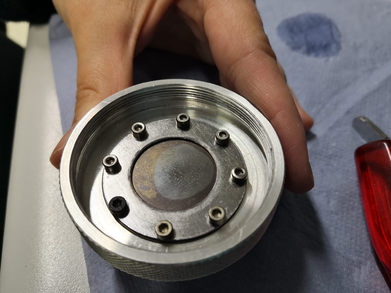
|
| Attachment 2: LNL9_back.jpg
|

|
|
29
|
Thu Jun 15 10:13:56 2023 |
Lucia B | 23Na target location |
Used and new 23Na targets are in a box in LAB7, next to the other targets |
|
28
|
Wed Jun 14 11:30:42 2023 |
Lucia B, Carlo B | LNL6-LNL2-LNL9 |
On 13/06/2023 afternoon we dismounted LNL6 sputtered target and mounted LNL2 (identical to LNL1, one Cr layer). We performed a scan of E_res=309 keV and left overnight under beam. In the morning 14/06/2023 we repeated the scan: the plateau has increased by 50% in height, but was much shorter. After dismounting, we notice witish dots around the beam spot.
We then mounted LNL9 (sputtered) and performed a scan. Very short plateau. We left for a long run.
Pictures of the targets attached (LNL6 after- LNL2 before and after - LNL9 before). |
| Attachment 1: LNL6_after_front.jpg
|

|
| Attachment 2: LNL6_after_back.jpg
|
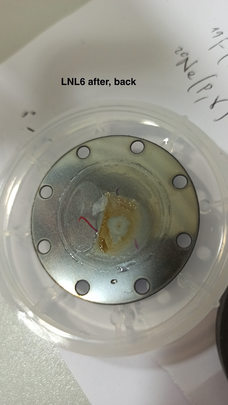
|
| Attachment 3: LNL6_after_back2.jpg
|
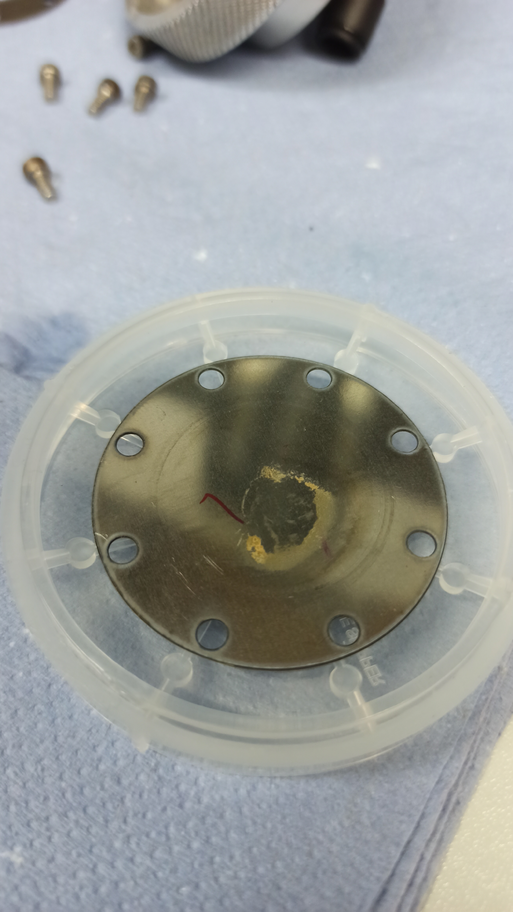
|
| Attachment 4: LNL2_before.jpg
|
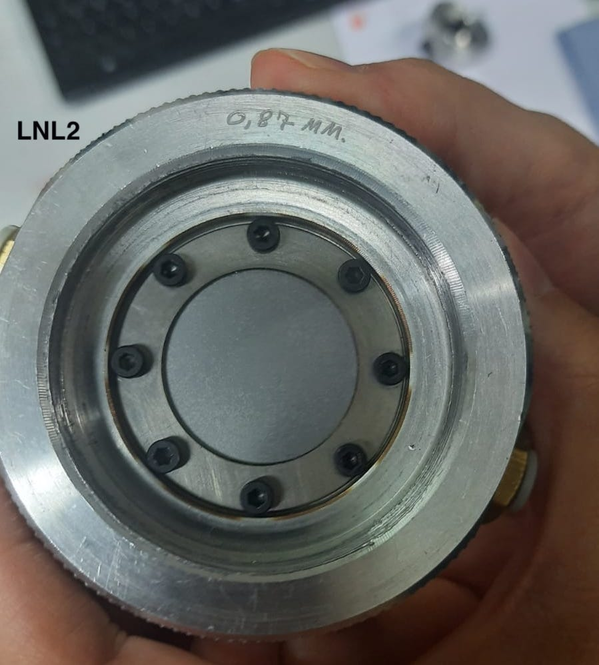
|
| Attachment 5: LNL2_after.jpg
|

|
| Attachment 6: LNL2_after_back.jpg
|
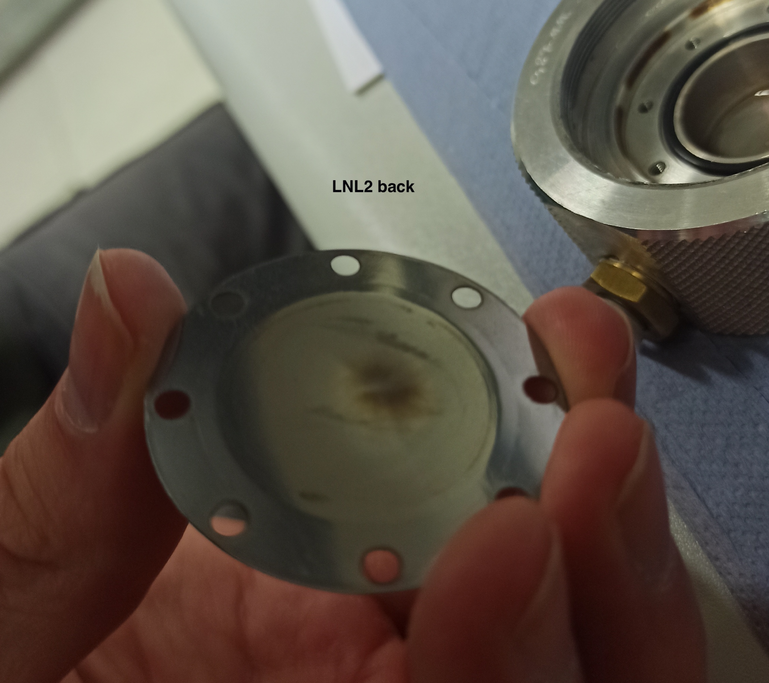
|
| Attachment 7: LNL9_before.jpg
|
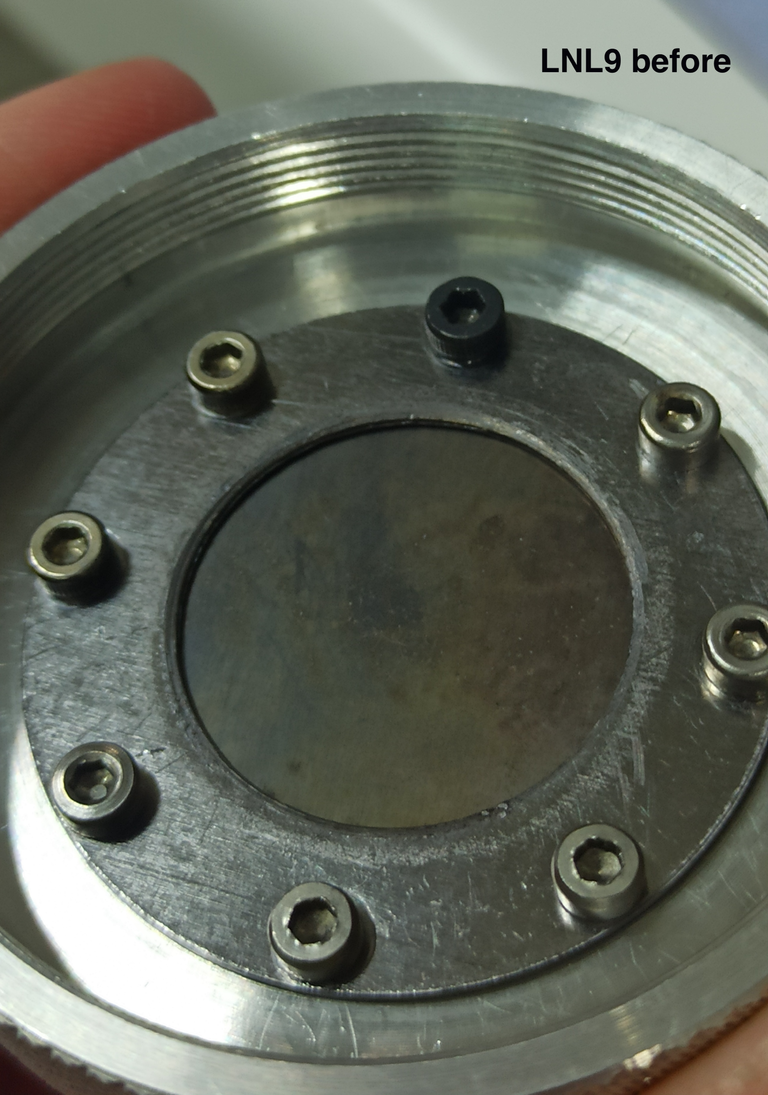
|
|
27
|
Tue Jun 13 12:44:05 2023 |
Lucia B, Carlo B | LNL4 dismounted - LNL6 mounted |
On 12/06/2023 we dismounted LNL4 after approximately 12 C were deposited.
We then mounted LNL6 (sputtered, in-air target). After a scan of 309 keV resonance, we left the target on for an overnight run. In the morning of 13/06/2023, the plateau was at the same level as the day before. We did another scan and left the target for few more hours under beam.
Pictures of targets attached (LNL4 after beam, LNL6 before beam) . |
| Attachment 1: LNL4_after.jpg
|
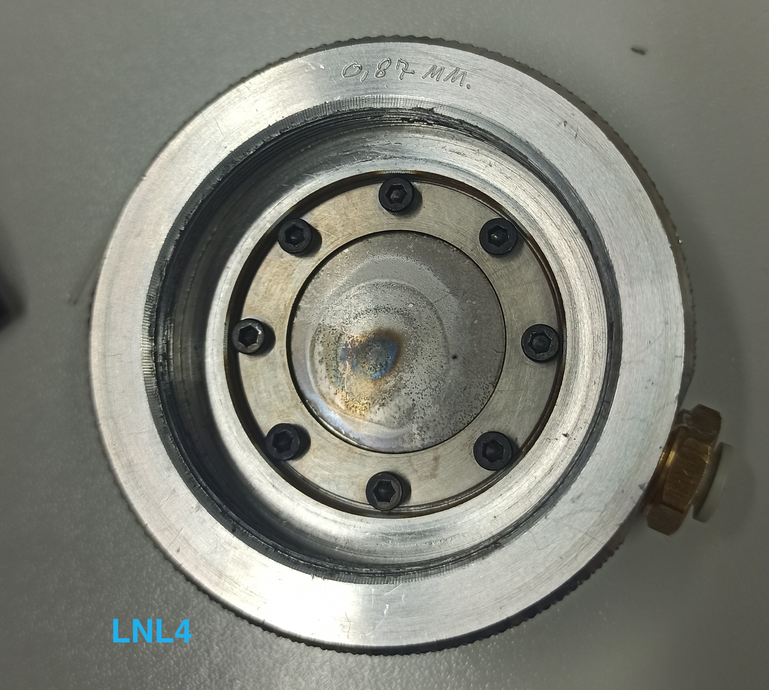
|
| Attachment 2: LNL6_before.jpg
|
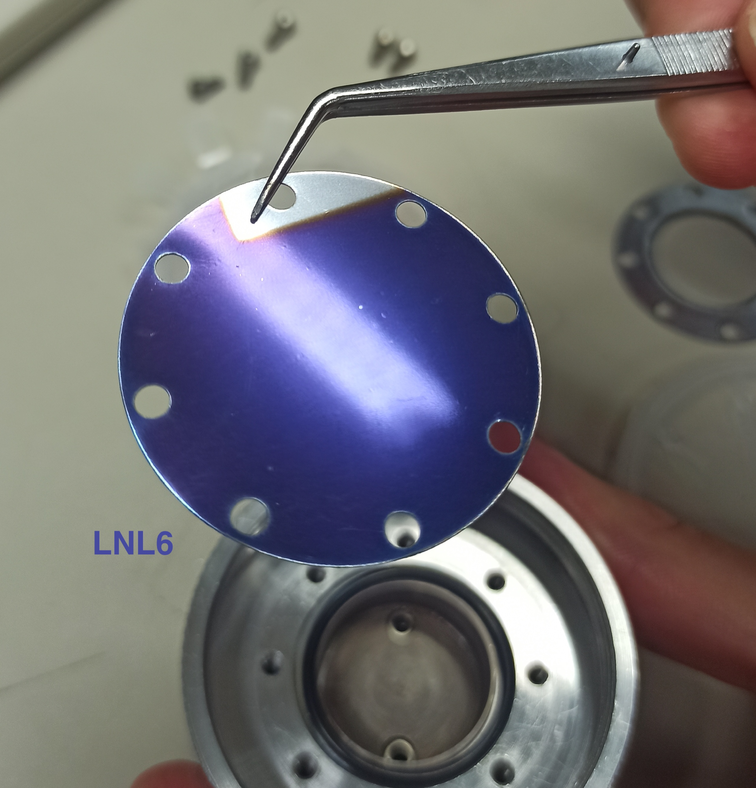
|
|
26
|
Sun Jun 11 09:18:23 2023 |
Lucia B, Carlo B | LNL4 |
When opening LNL4 target jar, the valve did not sound as if air was entering it: we suspect the target was actually not properly under vacuum.
We mounted LNL4 target. However, we could not start the measurement because of bad vacuum. Cold trap was warm. We did several N2 washings to get rid of any residual humidity in the beam line.
We had to dismount the target and do several tests with the leak finder before finding out that the problem was a broken O-ring between target and target holder AND damaged chiller's tube valve on target holder.
As a consequence, the target was exposed to air for quite some time. No visible degradation. Some pictures are attached.
We finally started the scan: details in the excel sheet. Target seems to have withstood air humidity! |
| Attachment 1: lnl4_before1.jpg
|
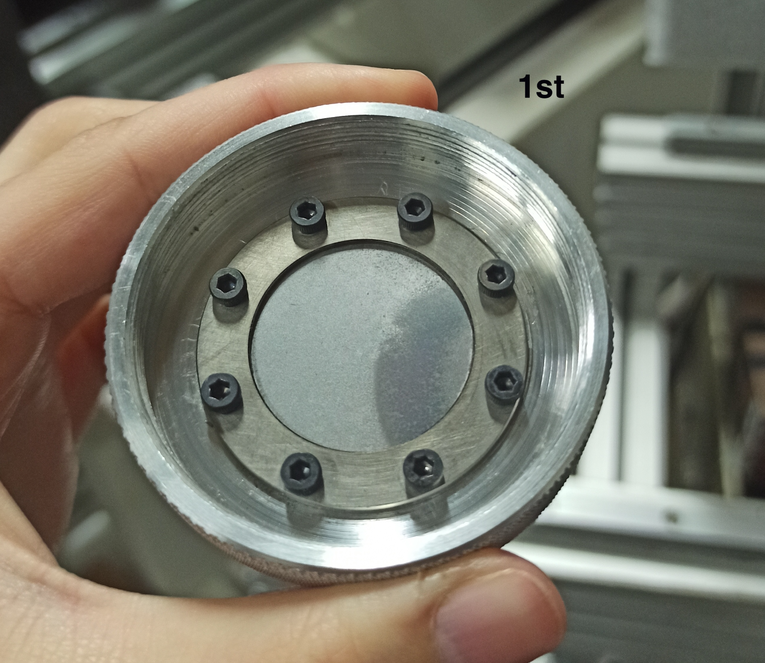
|
| Attachment 2: lnl4_before2.jpg
|
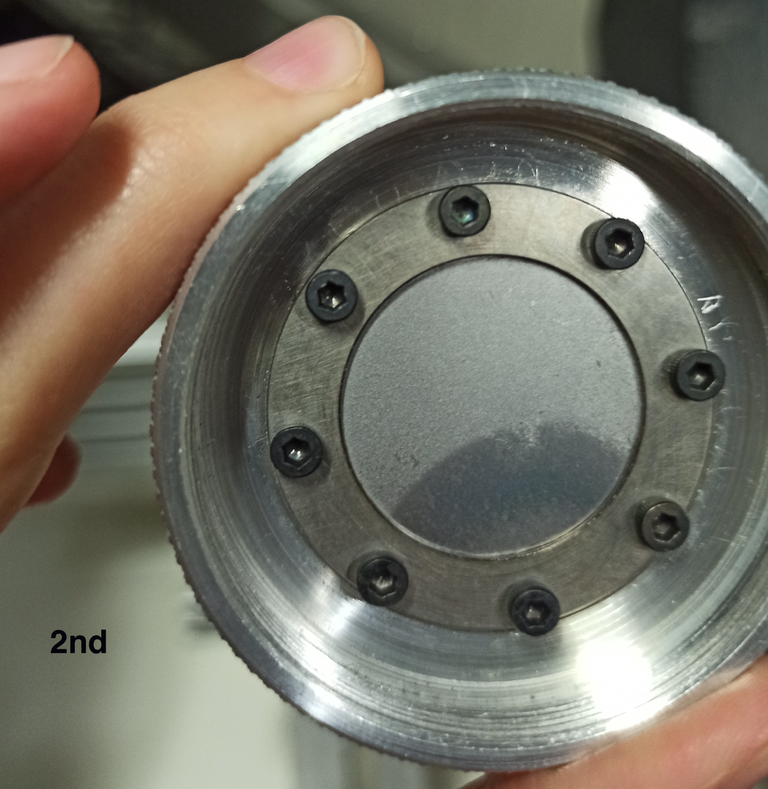
|
| Attachment 3: Lnl4_before3.jpg
|
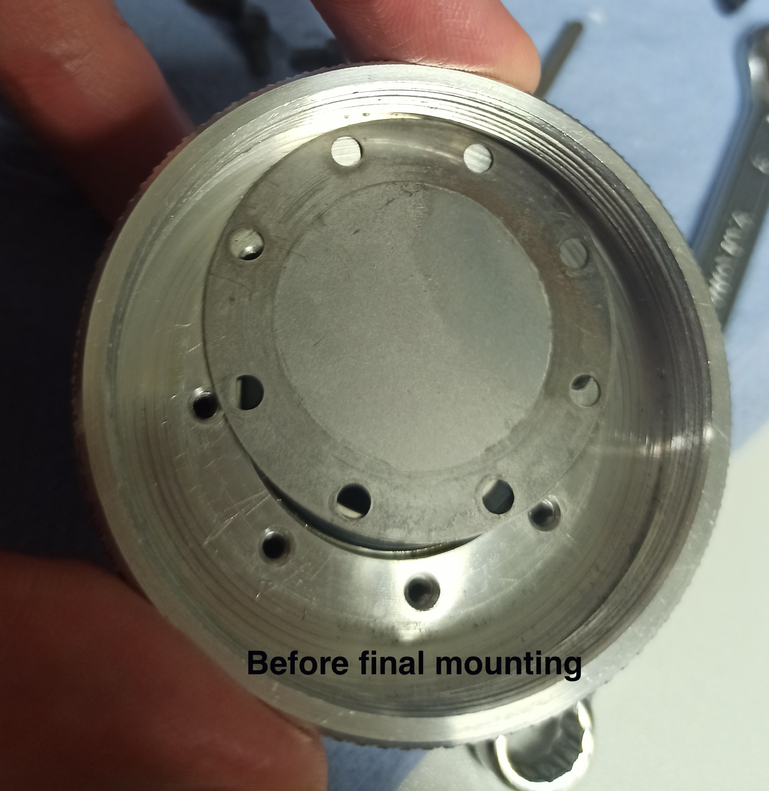
|
|
25
|
Fri Jun 9 13:47:24 2023 |
Lucia B, Carlo B | LNL1 |
We performed the scan on the LNL1 23Na target (details in the excel sheets in previous entry) for the E_p=309 keV resonance. The target has a sharp well defined rising edge, but it quickly deteriorates under beam bombardement (already after 0.1 C we can see the plateau height at same energy decrease). The thickness of the target also appears much larger than what recorded in the target info.
During the night between 8th and 9th June, we left a long run. In the morning we found the Faraday Cup closed and a pressure of a few mbar in the target chamber. We noticed one of the tubes of the chiller was open on the ground. This caused the chiller to stop working around 9pm. The target started to heat up and the tantalum was bent towards the chamber.
We did not find water in the chamber, it was probably spread on the ground before the chiller stopped working. Possibly a microscopic fracture was formed in the backing, causing air to flow inside the chamber and worsening the vacuum. The turbopump was however still on and does not seem damaged.
Pictures of the target before and after beam bombardment are attached.
|
| Attachment 1: 1686234338228.jpg
|
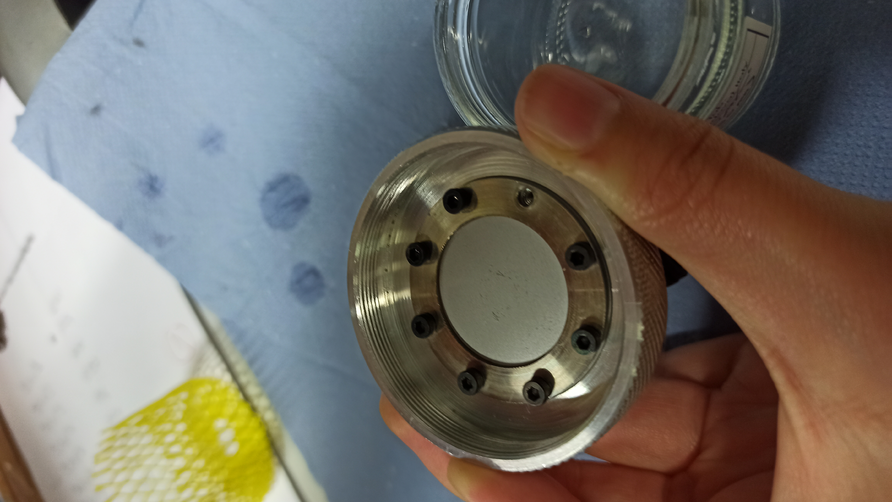
|
| Attachment 2: 1686314774177.jpg
|
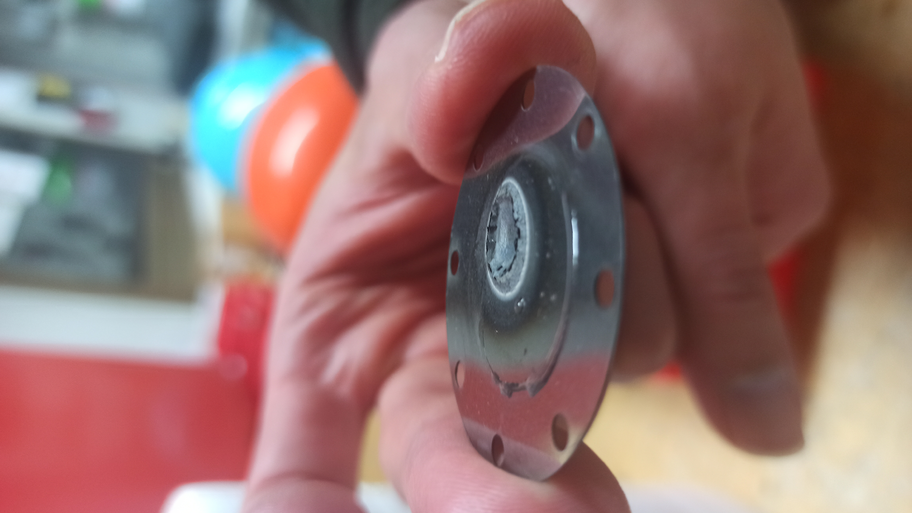
|
| Attachment 3: 1686314774200.jpg
|
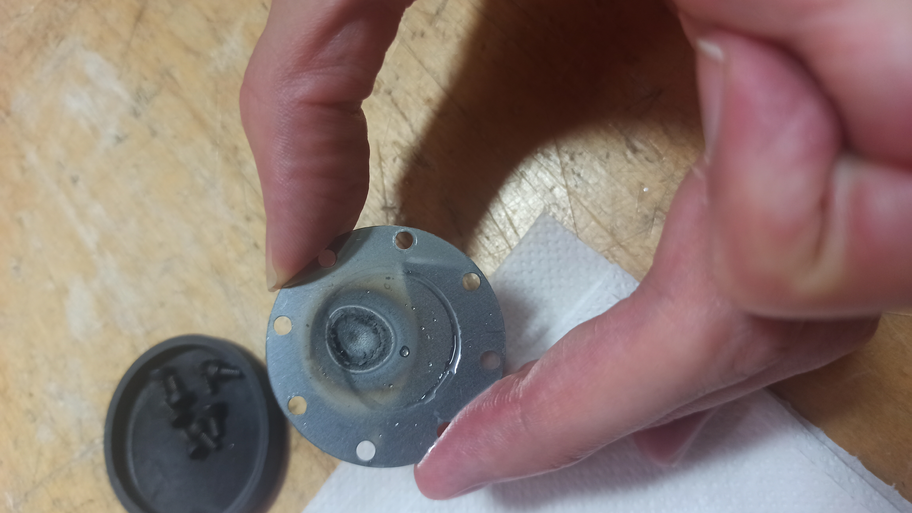
|
| Attachment 4: 1686315494678.jpg
|
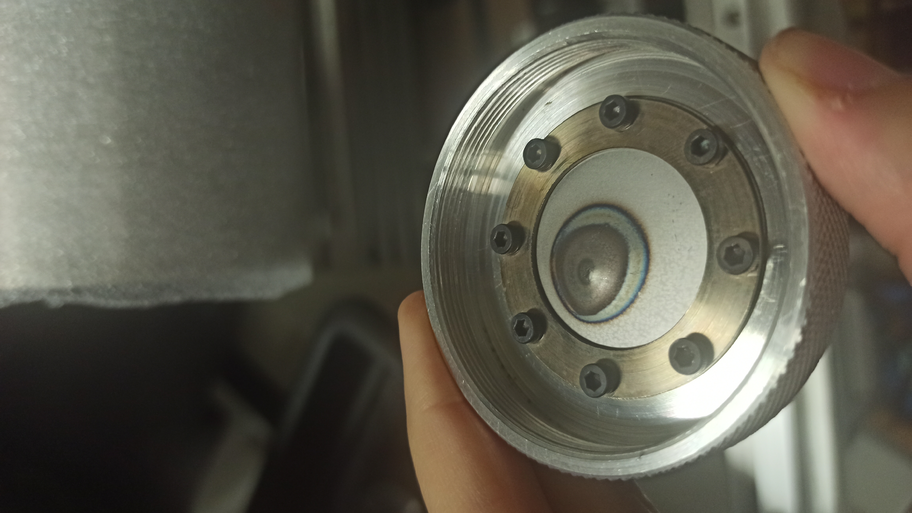
|
|
24
|
Thu Jun 8 10:36:26 2023 |
Lucia B, Carlo B | Start of the measurements |
We have started the pumping system and reached ~10^-6 mbar vacuum. We have then filled the cold trap reaching ~10^-7 mbar.
We have started the chiller and the measurement on the Ta backing on 7/6/23. We made a quick run on top of the 19F(p,gamma) resonance at e_p=340 keV, and an overnight run on top of the 11B(p,gamma) resonance at E_p=163 keV.
On 08/06/23 we focused the beam at E_p=309 keV (23Na(p,gamma) resonance) and left a run on the Ta overlunch.
More details in the attached Excel sheet. |
| Attachment 1: 23NaTarget_tests.xlsx
|
|
23
|
Tue Jun 6 11:15:31 2023 |
Lucia B,David R | Work on DAQ for 23Na target test |
Attached a picture of the germanium baseline in the morning 6/6/23.
-----------------------
We change the pulser amplitude to have it in the spectrum at what seemed a good position (A=150 mV).
We put 133Ba, 60Co and 137Cs sources in the shielding and started run_2 at Mon 6 June 2023, 12:15.
The run was stopped at 16:01. (Note there will be two ROOT files in the folder: one (2_1 for DataR_run_xx.root) is the automatic backup at 15:01, when the 'tentative' calibration on CeBr90 was enabled).
GeBo FWHM at 1.33 MeV is quite bad: 6.4 keV.
-------------------------------
We searched again in 16O log for optimal DAQ parameters and found them. We thave hen used them to see any possible resolution improvement. Spectrum is saved as run_3.
CeBr90 FWHM at 1.33 MeV is 46.10 keV.
GeBo FWHM at 1.33 MeV is 5.37 keV------------>with same parameters, 16O elog reports 3.42058 keV (Feb2023): note that Ge baseline thickness now is approximately 5mV, while in 16O elog I have found 2mV as reference, or slightly more from picture attached to same entry 110 Nov22).
Note that lowering the threshold at the 'optimal' values, we are cutting Ge spectrum at roughly 300 keV (which should not be a problem for 23Na+p resonance scan).
-----------------------------
We have mounted the Tantalum backing from Edinburgh (last spare, cleaned on 20/03/23 at LNGS) on the target holder and closed the beam line. We have left run_4 overnight as background run.
------------
Ge cryocooler is at 80K and 92 W.
|
| Attachment 1: GeBo_baseline-06-06-23.jpg
|
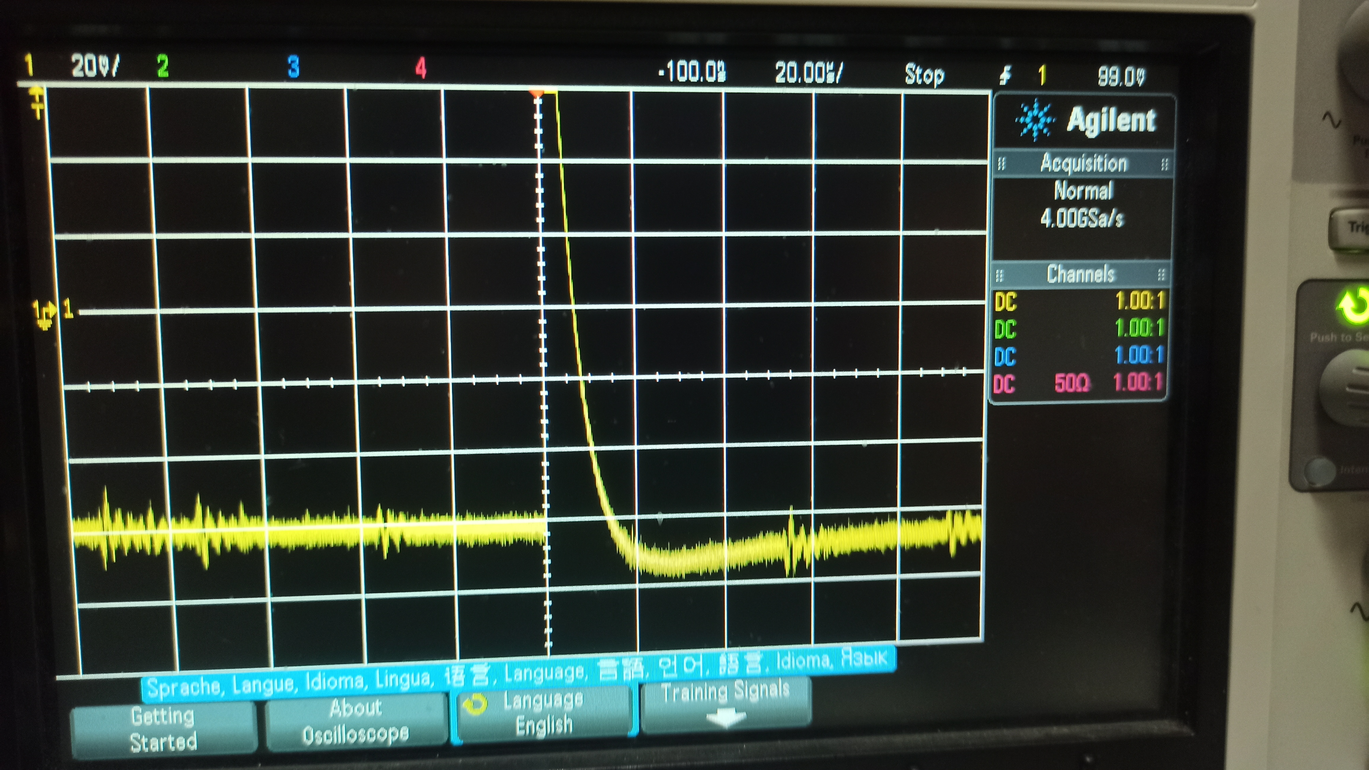
|
|
22
|
Mon Jun 5 15:48:47 2023 |
Lucia B,David R | Work on DAQ for 23Na target test |
We started the acquisition via CoMPASS with one CeBr (90) and the HPGe. The germanium was already cooled at 80K with a power of 90W. The CeBr HV was already applied from NHQ 202M bias supply, channel A, HV = +650V.
We applied the HV to the germanium on 5/6/23, from Ortec 660 dual bias supply borrowed from gas target, channel B, HV = +4900V, Bias shutdown connected.
Attached a picture of the baseline in the evening, before leaving the lab.
-----------------------
The DAQ from solid target is connected to the new Intel NUC mini-PC, located below the VME crate. It is possible to connect remotely to such PC using the RDP protocol (IP address -> 172.17.5.149). To connect from lunaserver, lauch Remmina and select lap2-depalo. Here, the CoMPASS project is located in /home/Compass/projects/23Na_target_tests.
We have also created the folder on lunaserver in /home/luna/Shared/Data/23Na_target_tests, where we copied from /home/luna/Shared/Data/16O_prompt the scripts required for possible binary conversions.
We are using three channels for the acquisition:
- Ch. 1: scintillator CeBr 90
- Ch. 2 : GeBo + pulser
- Ch. 3: Pulser
Pulser module BNC Model 9010 with following parameters:
- Amplitude 50 mV
- Frequency 24 Hz
- Delay 1 us
- Width 1 us
- Rise Time 0.05 us
- Fall Time 5 us
- Polarity: positive
- No attenuation
We left an overnight background run (run_1).
|
| Attachment 1: GeBo_baseline-5-6-23.jpg
|
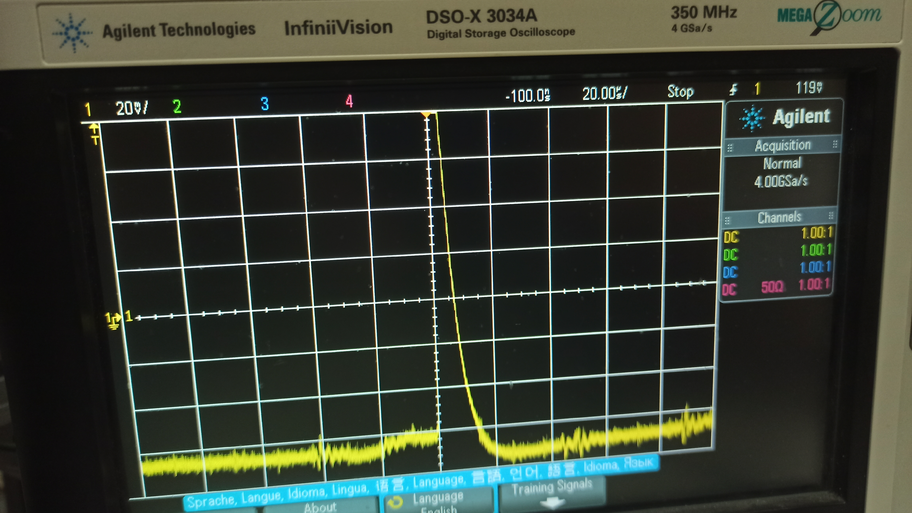
|
|
21
|
Wed Jun 23 08:23:07 2021 |
CB | R14 analysis 2 |
Given very poor fit using line + power law + line, changes were made to the fitting algorithm.
- Starting paramters optimised for new typical wave shape
- Reverted to 3 lines, since signals are faster
- Subtracted wave minimum from all wave points to have a more realistic chi2 estimate
- Discarded all waves where 2nd half of signal > 1st half of signal. Should correspond to pick-up / noise
Fit: 3 lines
Free parameters: 2x boundary points between lines
Algorithm: Nelder-Mead, 20 iterations.
Attach 1: Wave amplitudes
Attach 2: Rise times
No major differences vs. power law method, but note candidate electron peak in rise time spectrum is now sharper.
Attach 3-9: Waveforms with H~90 and increasing rise times.
Note fit shown are via Solver's GRG, not NM.
Fits in waves 1-4 give same result for GRG and NM.
Fit in wave 5: NM-> H72 t102 vs. GRG-> H80 t25
Fit in wave 6: NM-> H96 t128 vs. GRG-> H90 t23
GRG risetimes are more realistic. This appears to be due to very short baseline pre-rise.
Will increase in next run.
Fit in wave 7 is rare pile-up event. Code cannot yet cope. Bad fit. |
| Attachment 1: H.png
|
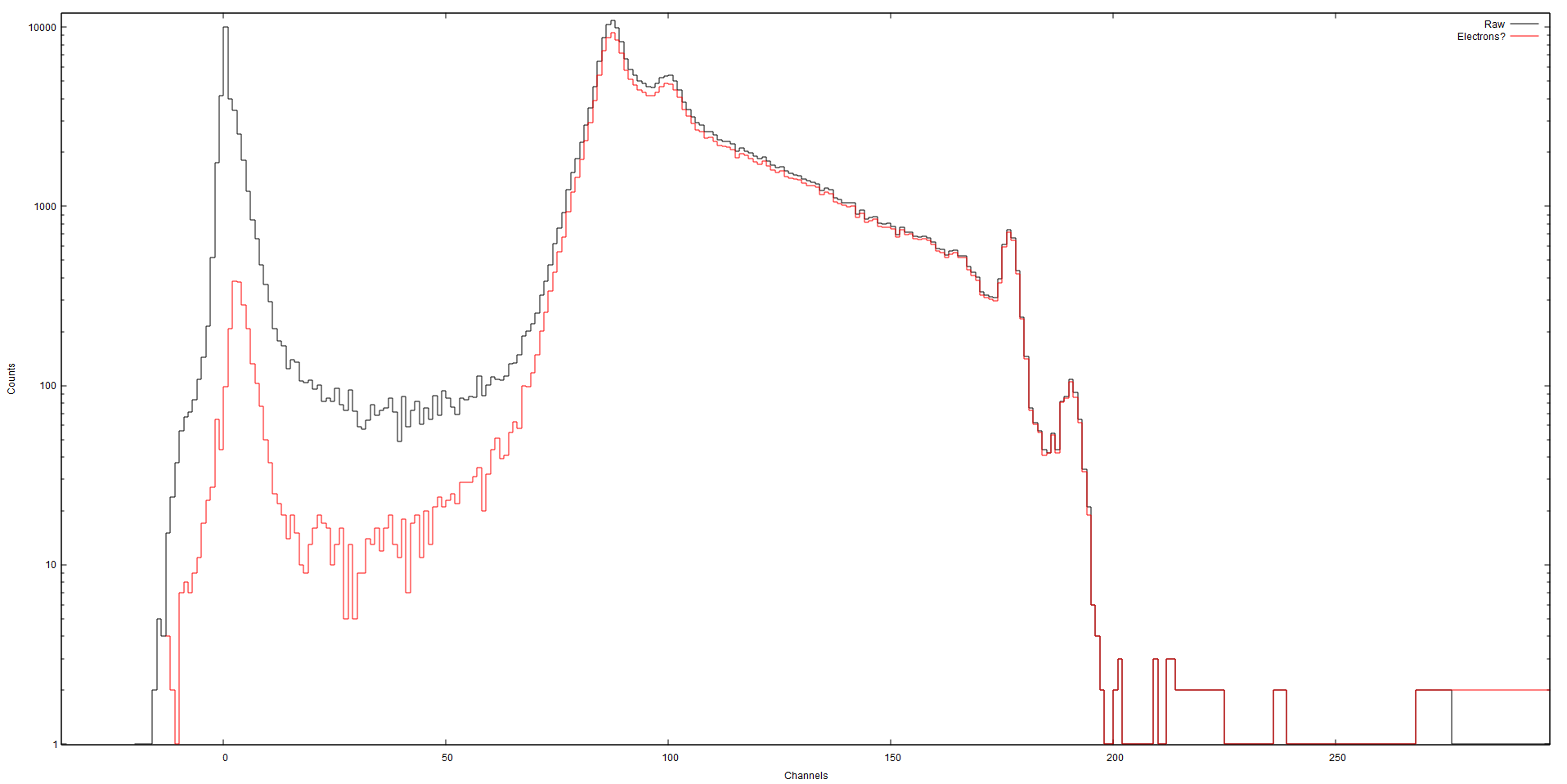
|
| Attachment 2: t.png
|
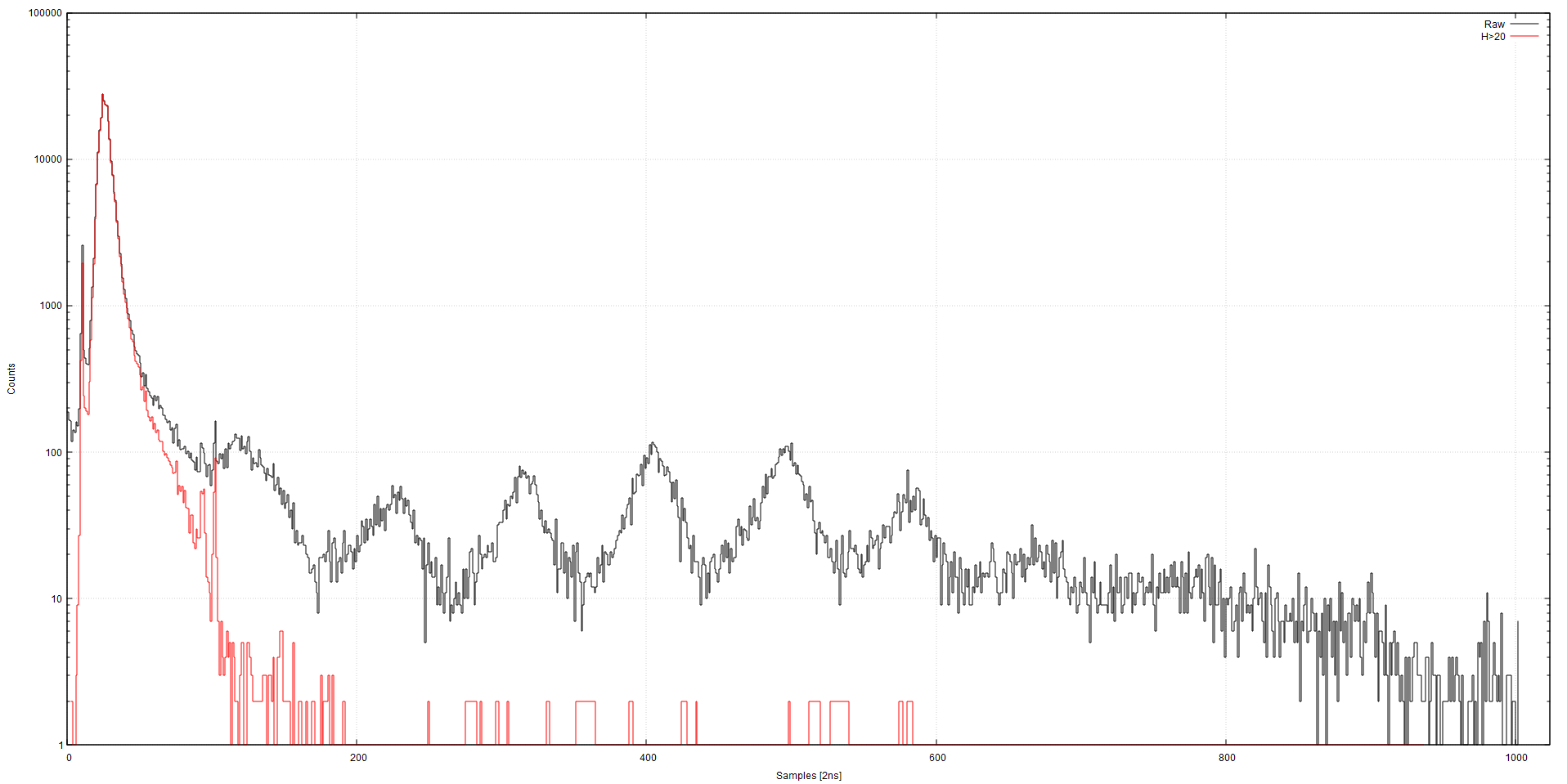
|
| Attachment 3: H86t21.png
|
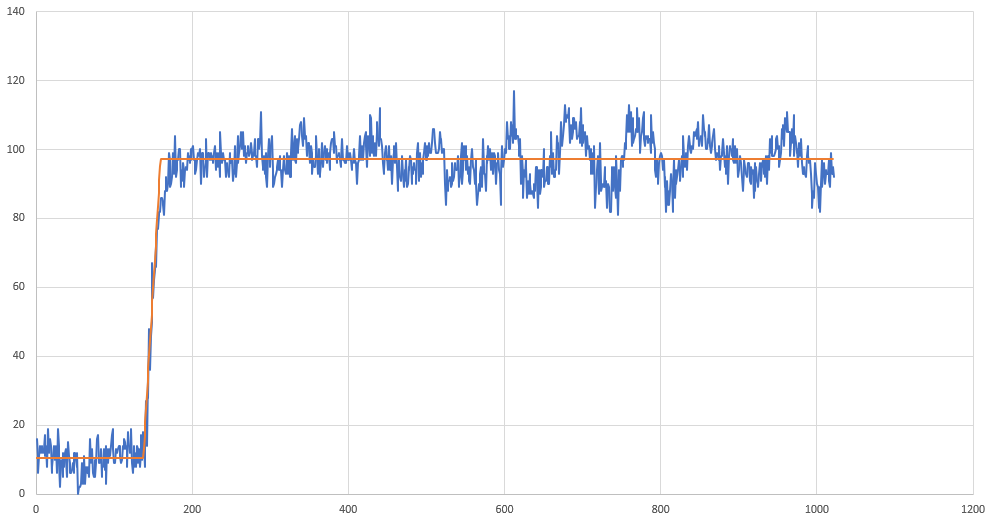
|
| Attachment 4: H143t44.png
|

|
| Attachment 5: H86t65.png
|
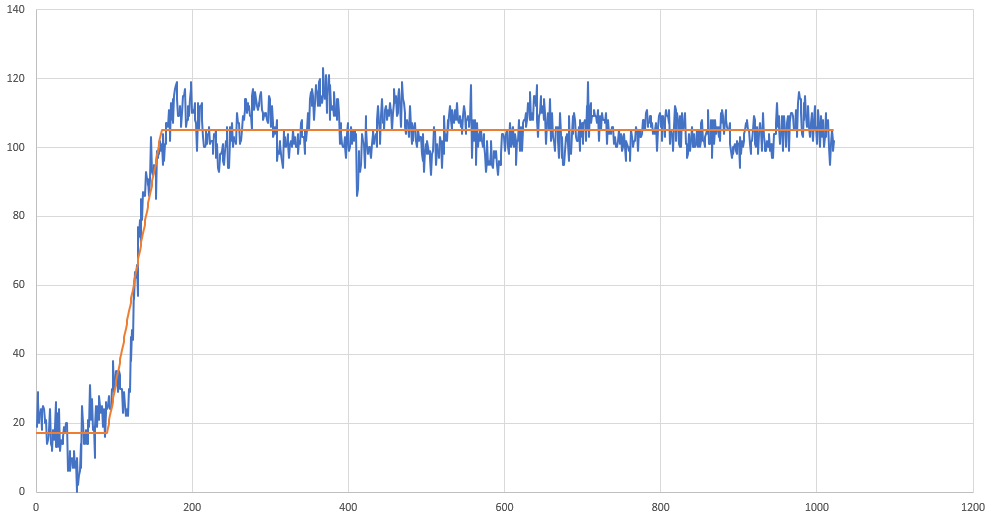
|
| Attachment 6: H99t84.png
|
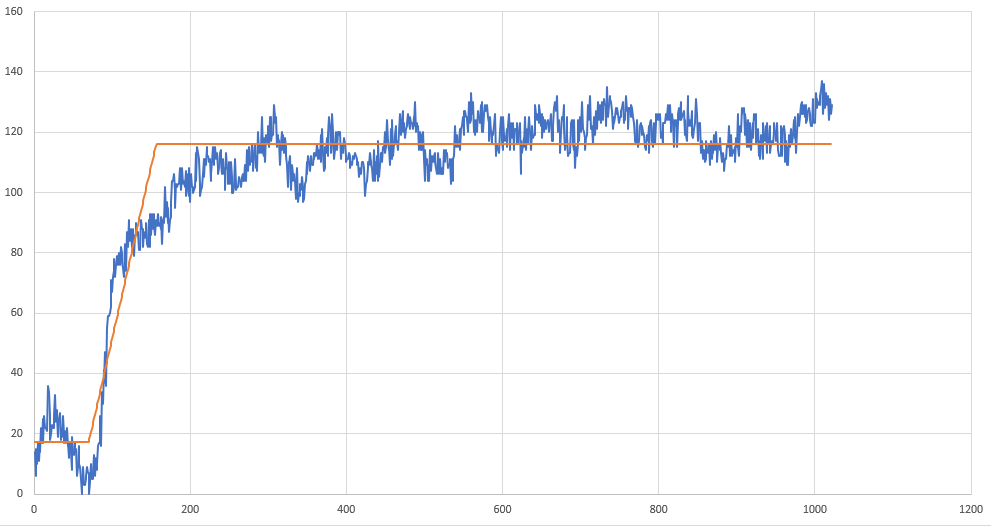
|
| Attachment 7: H72t102.png
|
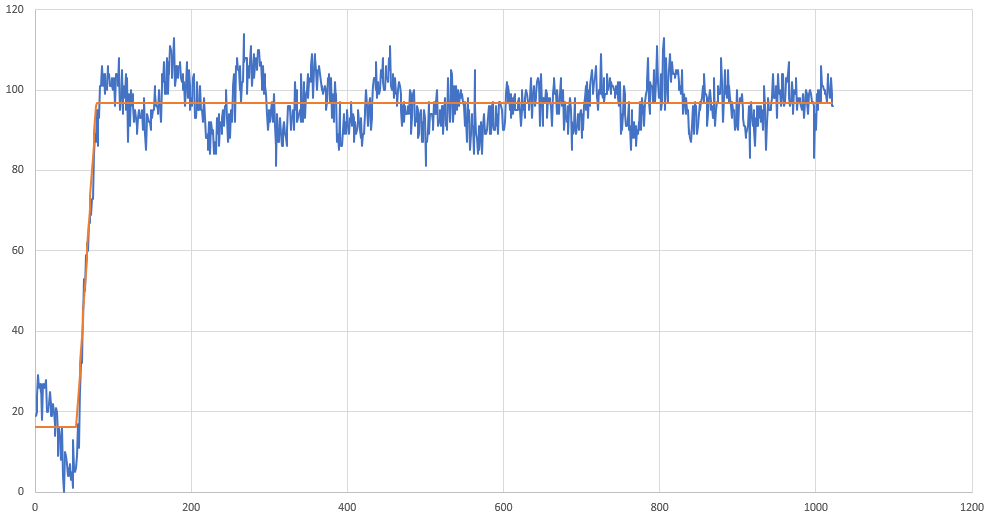
|
| Attachment 8: H96t128.png
|
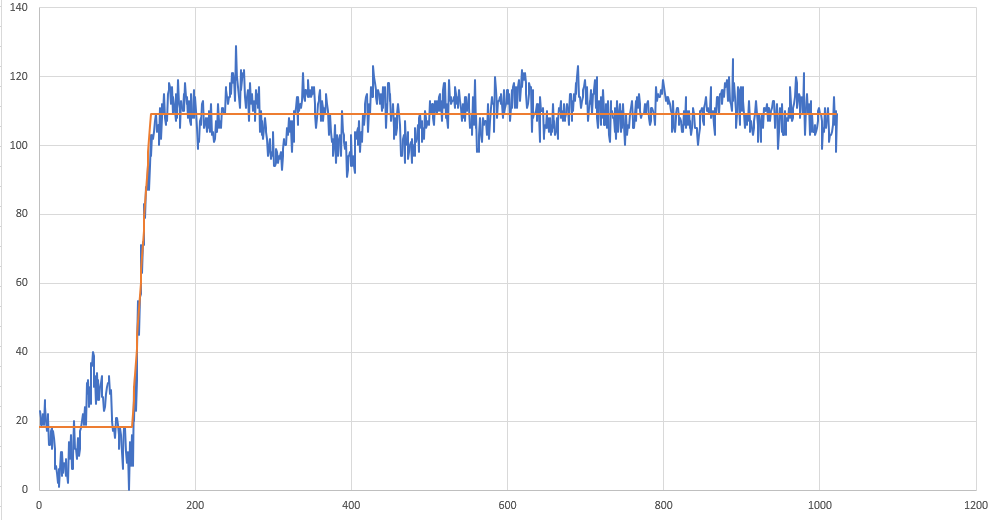
|
| Attachment 9: H94t148.png
|
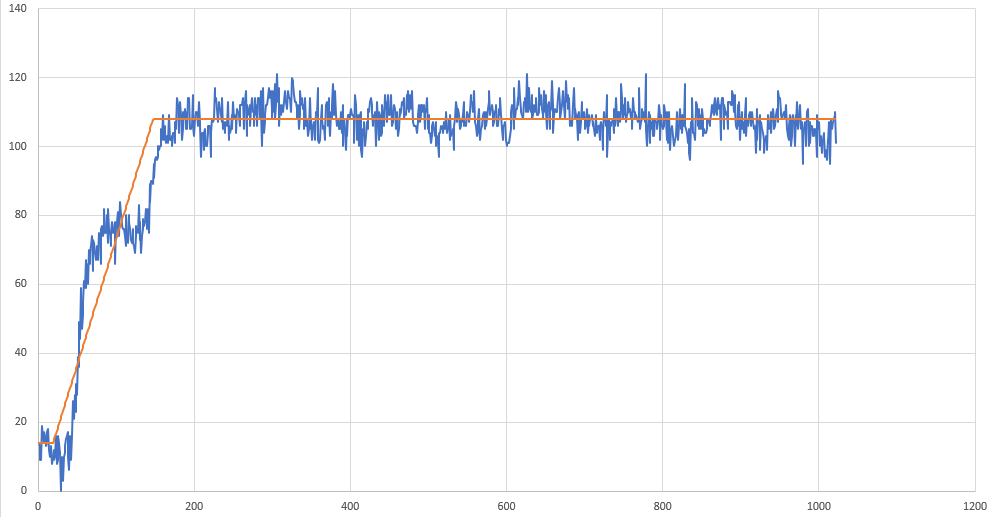
|
|
20
|
Tue Jun 15 13:15:48 2021 |
CB | R14 analysis |
Fit: line + power law + line
Free parameters: 2x boundary points between lines
Algorithm: Nelder-Mead, 20 iterations.
Attach 1: Wave amplitudes.
Pulse not shown at 1000 channels.
Obvious signal from Bismuth source with visible peaks. Not all peak origins clear.
Attach 2: Risetimes.
Pick-up / microphonic noise quite evident (compare with background run with B-grade silicon)
Pulser relatively well-defined in risetimes
Electrons not well defined
Attach 3: Waveform for electron candidate fitted as risetime = 26 samples
Attach 4: Waveform for electron candidate fitted as risetime = 153 samples
Visual difference between the two unclear, aside from noise.
Looks like fitting function is failing. Will have to change algorithm to draw any conclusions. |
| Attachment 1: H.png
|

|
| Attachment 2: t.png
|

|
| Attachment 3: Electron_t26.png
|
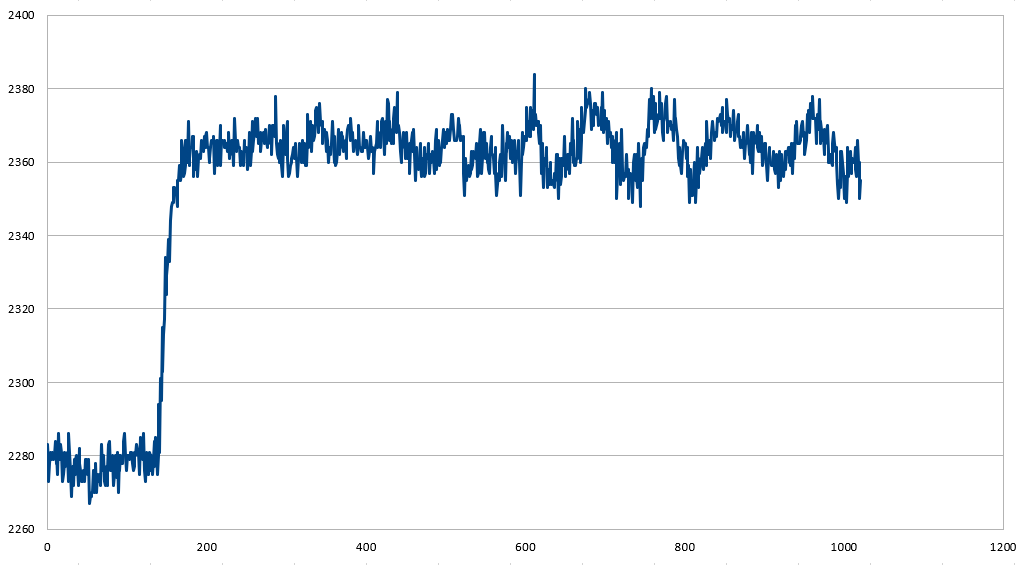
|
| Attachment 4: Electron_t153.png
|

|
|
19
|
Tue Jun 15 09:52:10 2021 |
CB, PB | 2021 Runs - Hamamatsu diode |
Using a 1x1 Hamamatsu photodiode (uncoated)
+75V bias supplied via RAL108 and standard photodiode mount. Imon ~0
Note negative bias would be supplied with standard lemo cable + standard mount.
Positive bias supplied via modified lemo cable to read *positive* pulses after RAL108 preamp
->CHANGED dynamic range to 0.5 Vpp (from 2 Vpp)
R14
Positive signals
2.5 Hz Pulser
1024 window / 600 pre-gate trigger
70 threshold / 2300 baseline
55098 DC offset
208Bi source
DAQ stopped acquiring for unknown reasons at 22:30.
Enough data to analyse.
Swapped Bi source for 3-alpha. Had to move diode around.
Pick-up / microphonic noise much worse now. Baseline too unstable to trigger.
Giving bias results in 1 uA / 25 V current (vs. ~0 before).
No alphas can be seen.
Further investigation needed.
After plugging/uplugging wire from diode leakage current no longer grows to 1 uA / 25 V when giving bias.
Behaviour appears inconsistent. Heat shrink applied to makeshift connector to improve situation. Now running
without leakage current at 75 V.
Note 208Bi source was found to be leaky and removed.
R15
Positive signals
2.5 Hz Pulser
1024 window / 650 pre-gate trigger
70 threshold / 2300 baseline
55098 DC offset
3-alpha source |
|
18
|
Fri Jun 11 10:56:45 2021 |
CB | R13 |
Fit: line + power law + line
Free parameters: 2x boundary points between lines
Algorithm: Nelder-Mead, 20 iterations.
Attach 1: Wave amplitudes.
Peak at 300 is pulser.
Some physics events in between obvious noise and pulser.
No obvious signal from Bismuth source
Attach 2: Alpha (?) wave sample. Rise time ~ 200 samples.
In spite of no signal from source, some alphas are visible. |
| Attachment 1: H.png
|

|
| Attachment 2: Alpha_candidate.png
|
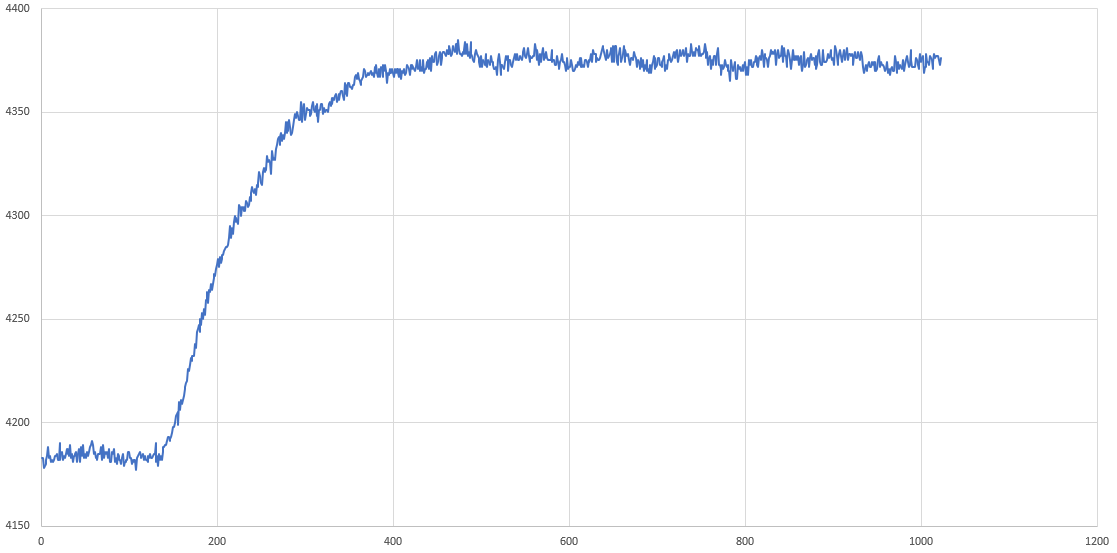
|
|
17
|
Tue Jun 8 11:04:36 2021 |
CB | R11 (long background) dead time |
Pulser frequency: 2.165 Hz (462 ms)
Attach 1: Pulser events vs. total events
| |
Pulser |
Live time |
Real time |
Dead % |
|
|
File closed |
| R11_0 |
160369 |
74090.48 |
? |
? |
|
R11_0 |
31/05/2021 04:17 |
| R11_1 |
141823 |
65522.23 |
66398 |
1.3% |
|
R11_1 |
31/05/2021 22:43 |
| R11_2 |
124032 |
57302.78 |
58105 |
1.4% |
|
R11_2 |
01/06/2021 14:52 |
| R11_3 |
156246 |
72185.65 |
73096 |
1.2% |
|
R11_3 |
02/06/2021 11:10 |
| R11_4 |
121917 |
56325.65 |
57054 |
1.3% |
|
R11_4 |
03/06/2021 03:01 |
| R11_5 |
102395 |
47306.49 |
47871 |
1.2% |
|
R11_5 |
03/06/2021 16:19 |
| R11_6 |
78135 |
36098.37 |
36472 |
1.0% |
|
R11_6 |
04/06/2021 02:26 |
| R11_7 |
93972 |
43415.06 |
43822 |
0.9% |
|
R11_7 |
04/06/2021 14:37 |
| R11_8 |
120559 |
55698.26 |
56305 |
1.1% |
|
R11_8 |
05/06/2021 06:15 |
| R11_9 |
112937 |
52176.89 |
52749 |
1.1% |
|
R11_9 |
05/06/2021 20:54 |
| R11_10 |
126019 |
58220.78 |
58875 |
1.1% |
|
R11_10 |
06/06/2021 13:16 |
| R11_11 |
119971 |
55426.6 |
56068 |
1.1% |
|
R11_11 |
07/06/2021 04:50 |
| R11_12 |
19822 |
9157.764 |
9260 |
1.1% |
|
R11_12 |
07/06/2021 07:24 |
|
| Attachment 1: Pulser.png
|
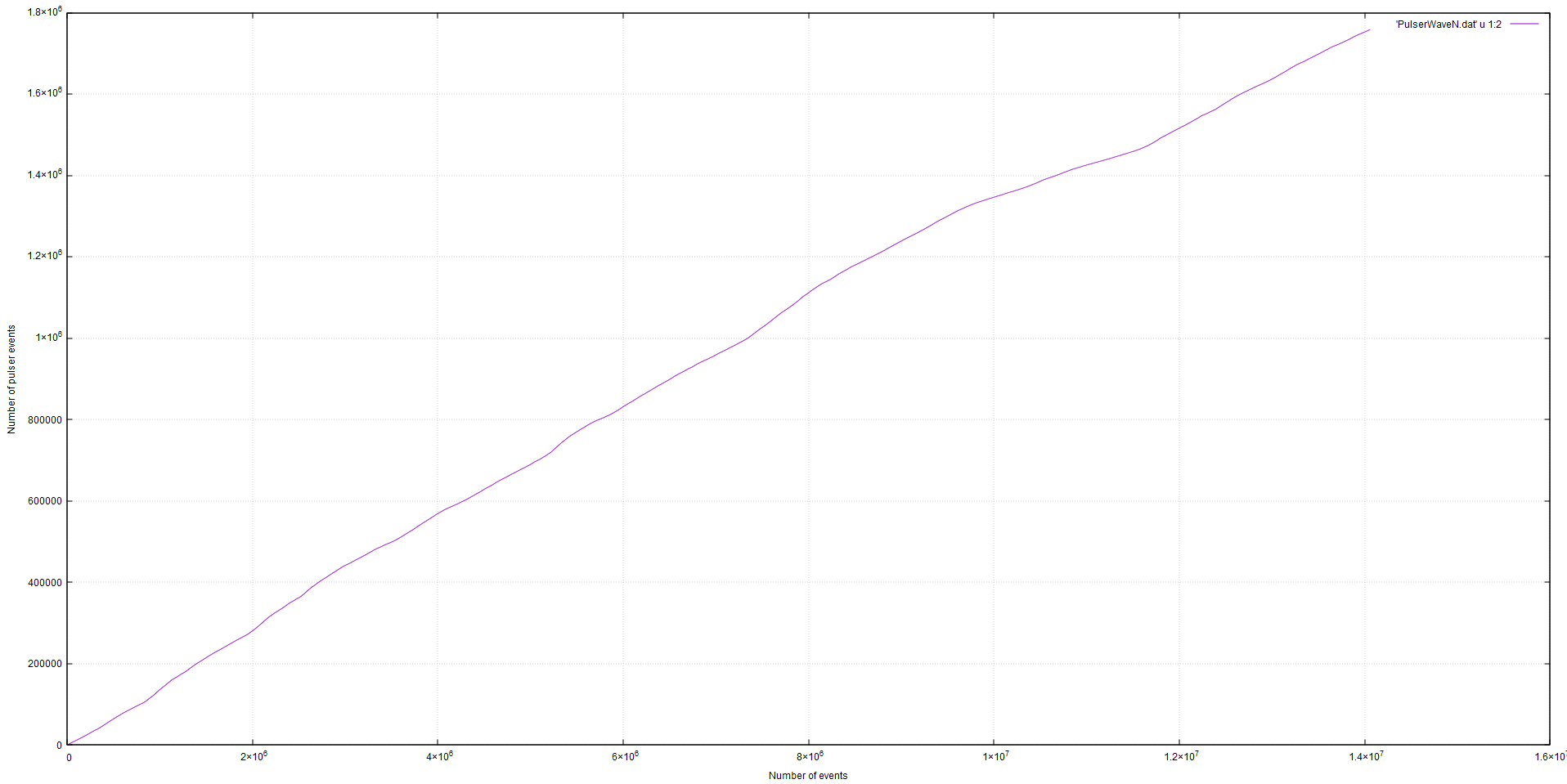
|
|
16
|
Mon Jun 7 17:41:55 2021 |
CB | Long background analysis |
Fit: line + power law + line
Free parameters: 2x boundary points between lines
Algorithm: Nelder-Mead, 20 iterations.
Attach 1: Rise times.
Peak below 200 is pulser.
200 samples should correspond to alphas, according to R3 analysis. 600+ should correspond to slow signals
(electrons?)
Attach 2: Wave amplitudes (pulser not shown).
150-200 channels should be correspond very roughly to 5-6 MeV
Attach 3: An alpha candidate signal. H 163 t 198
Attach 4: A slow physics signal (electron?) candidate. H 100 t 651
Attach 5: Noise with low Chi2. Reported as H2 t 406. Note fit is GRG nonlinear - cannot reproduce dataReader
Nelder-Mead Simplex fit in Excel (working on it).
Attach 6: Noise with high Chi2 value. Reported as H40 t150. As above.
Attach 7: 2D heatmap |
| Attachment 1: t.png
|

|
| Attachment 2: H_bin.png
|
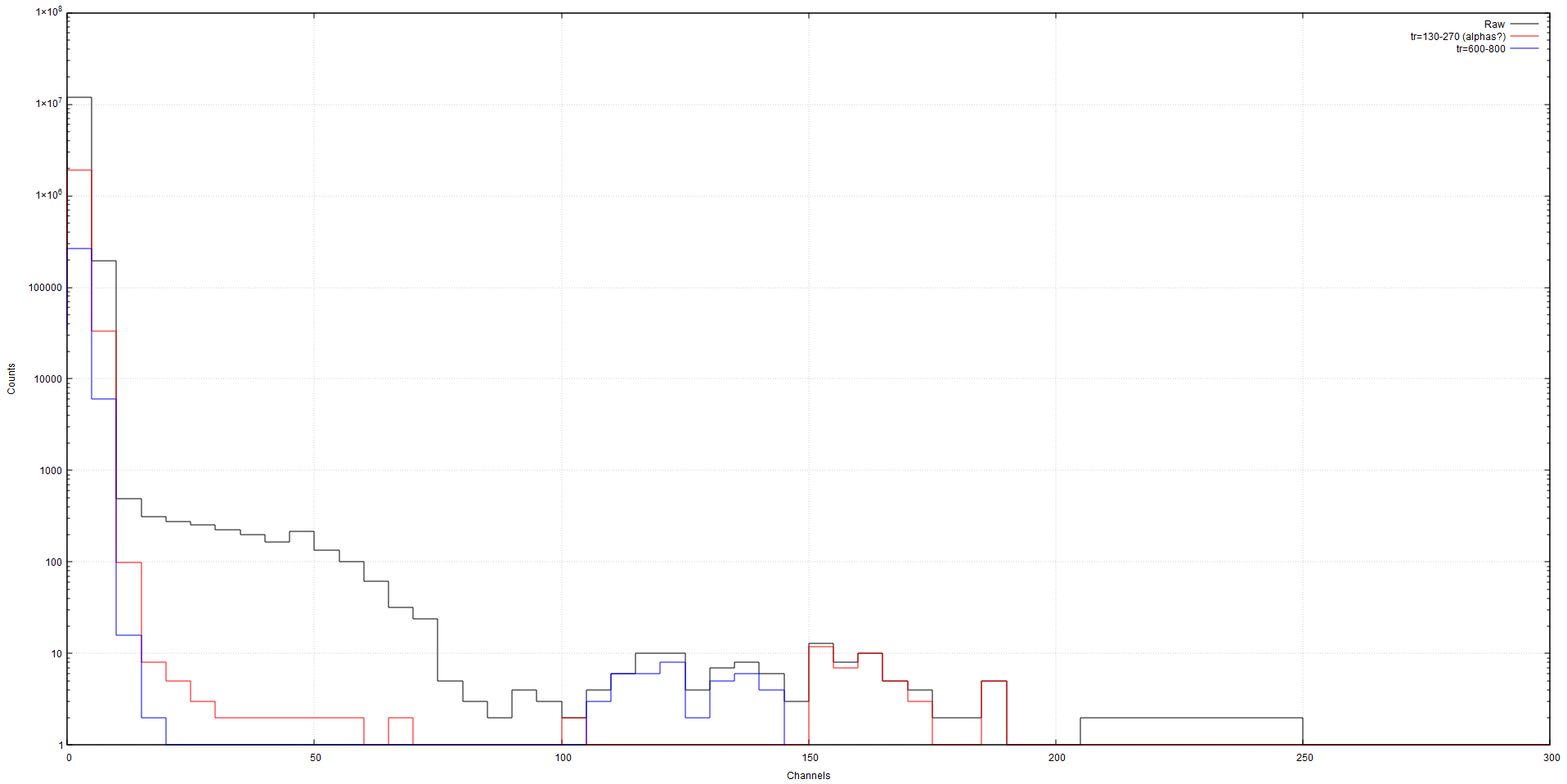
|
| Attachment 3: H163_t198.png
|
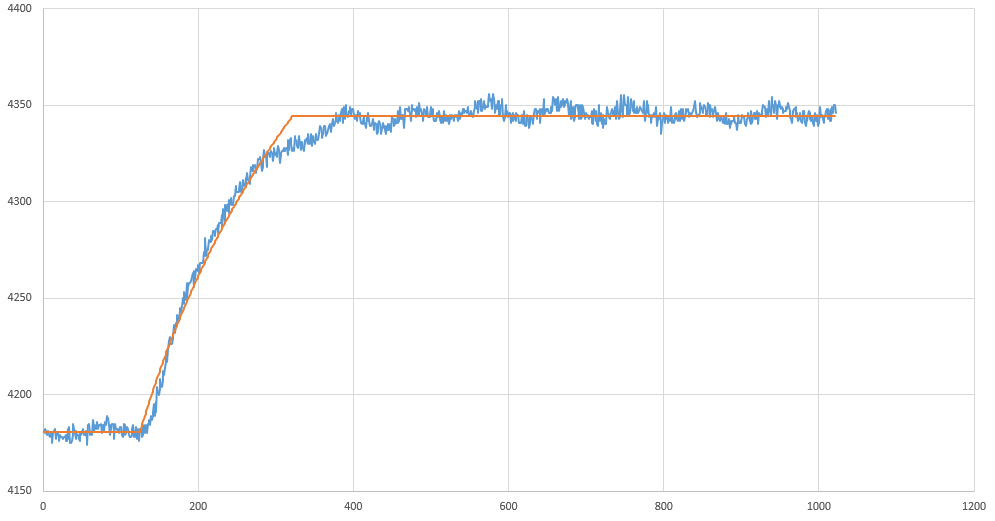
|
| Attachment 4: H110_t651.png
|
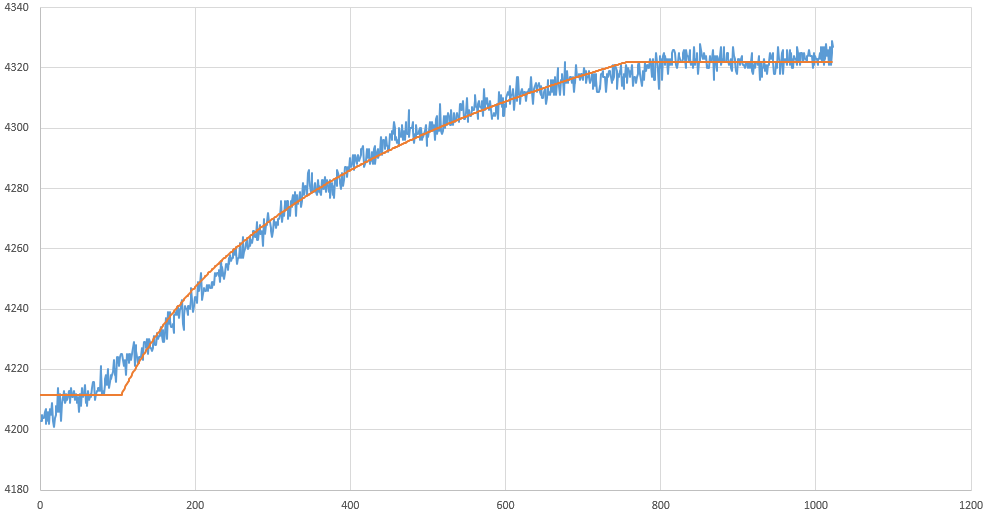
|
| Attachment 5: LowChi2noise.png
|
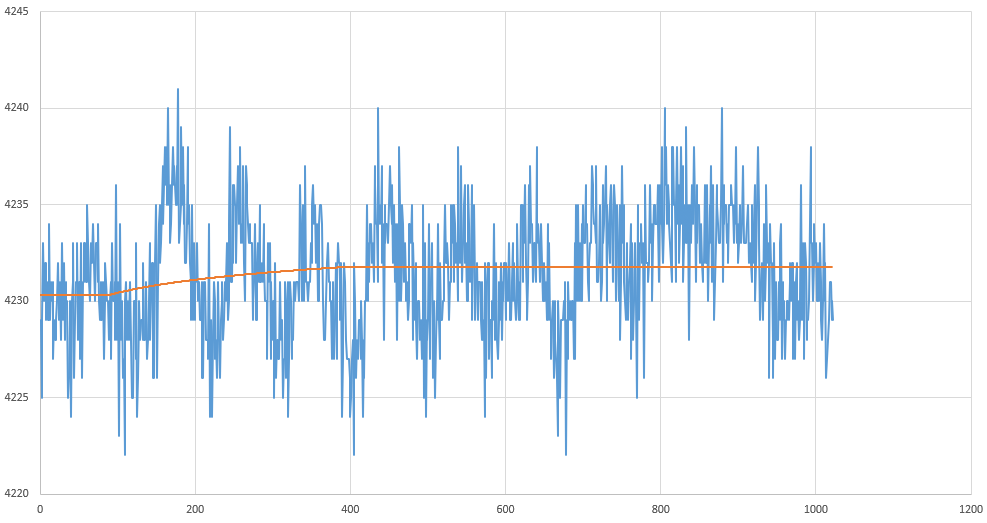
|
| Attachment 6: HighChi2noise.png
|
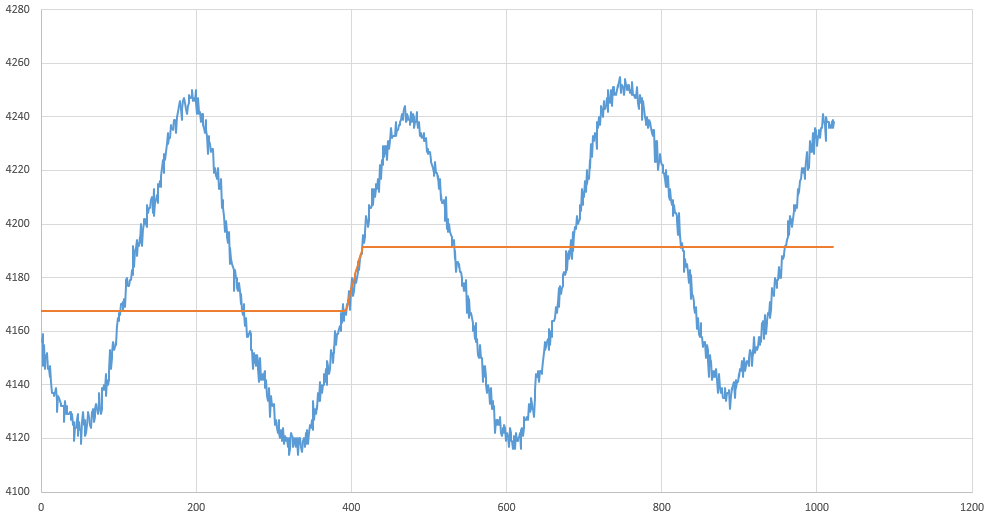
|
| Attachment 7: Background.png
|

|
|
15
|
Wed Jun 2 10:26:31 2021 |
CB | 2021/R3_0 Analysis - 2 lines + power law - 20 iterations |
Fit: line + power law + line
Free parameters: 2x boundary points between lines
Algorithm: Nelder-Mead, *20* iterations.
Attach 1: rise times for H>20. Main peak is now double.
Attach 2: heights. Second rise time peak corresponds to four peaks at alpha energies. physical origin unclear.
Overfitting?
Attach 3: comparison between waves of two rise time peaks |
| Attachment 1: H.png
|

|
| Attachment 2: t.png
|

|
| Attachment 3: Comparison.png
|
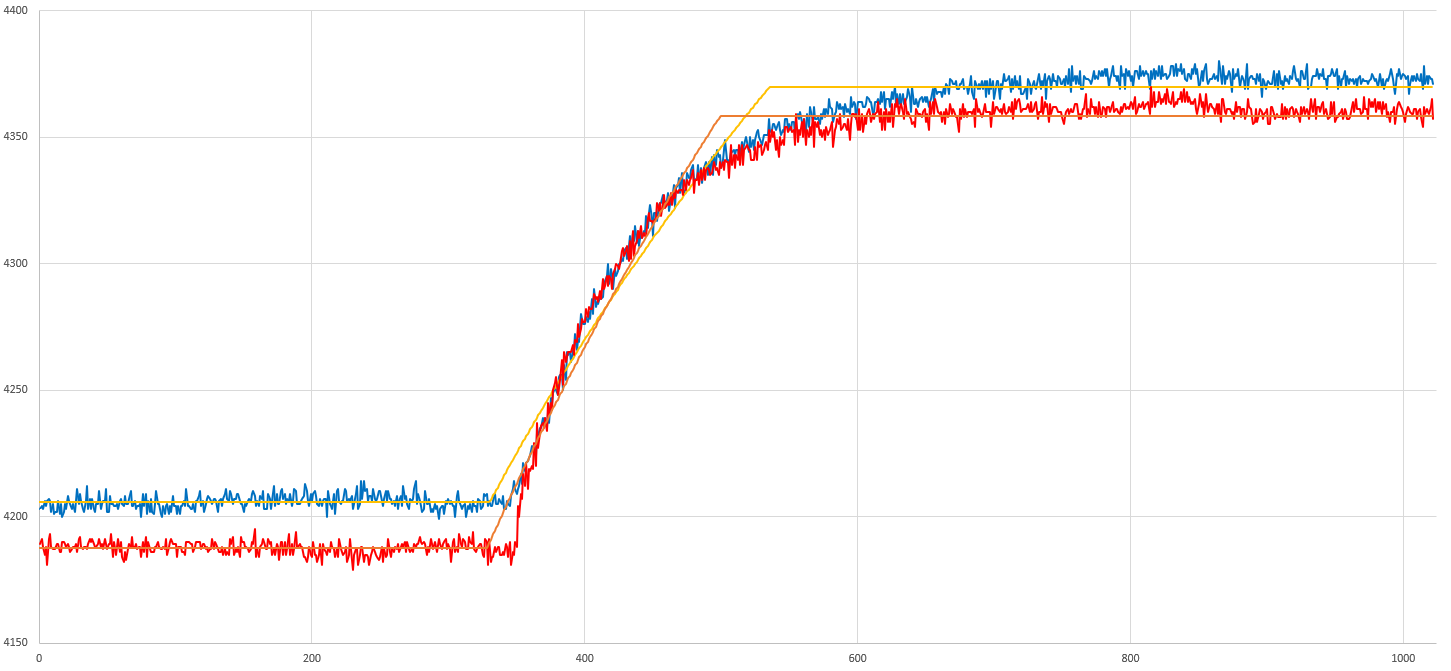
|
|
14
|
Tue Jun 1 15:19:40 2021 |
CB | 2021/R3_0 Analysis - 2 lines + power law |
Fit: line + power law + line
Free parameters: 2x boundary points between lines
Algorithm: Nelder-Mead, 10 iterations. (centroid correct)
Attach 1 - height (difference between intercepts)
Attach 2-8 - Signals with H~110, different t values (see filenames).
Note t=370 and t=870 show discontinuities in the middle of the rising front. Pick-up?
Attach 9 - Comparison of the above. Note t=370-570 look visually similar in spite of very different fit results.
Pulser *not* shown
Attach 10 - Heat map
Attach 11 - rise times (x-diff between boundary points), for H>20 (no noise) |
| Attachment 1: R3pow_H.png
|
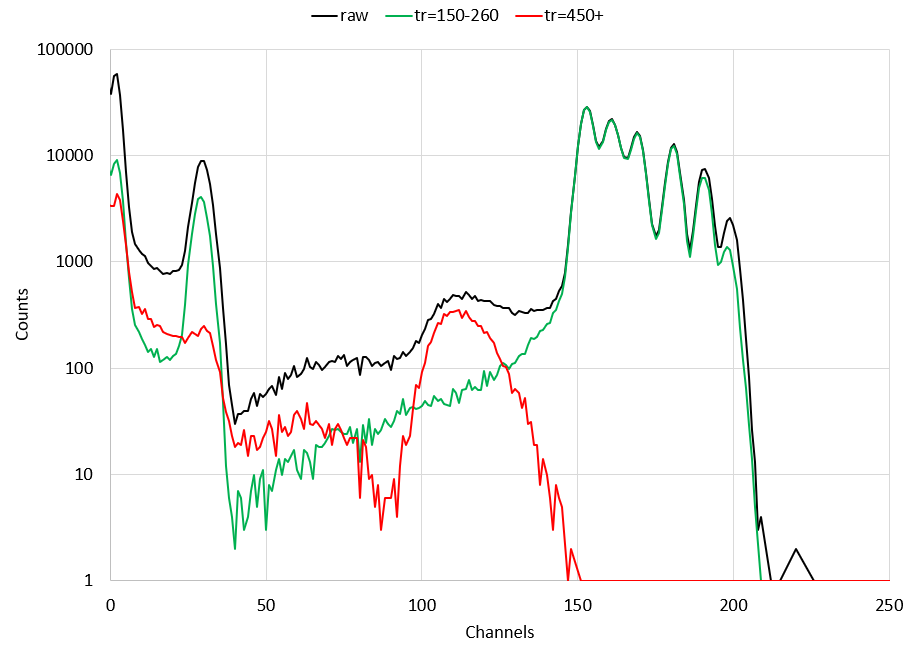
|
| Attachment 2: H135t170.png
|
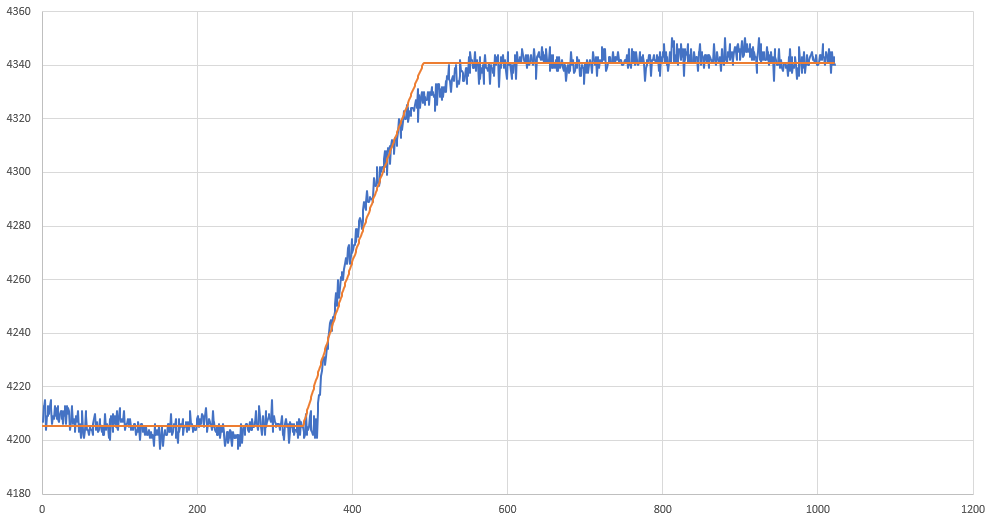
|
| Attachment 3: H131t270.png
|

|
| Attachment 4: H122t370.png
|

|
| Attachment 5: H127t470.png
|

|
| Attachment 6: H115t570.png
|

|
| Attachment 7: H107t670.png
|
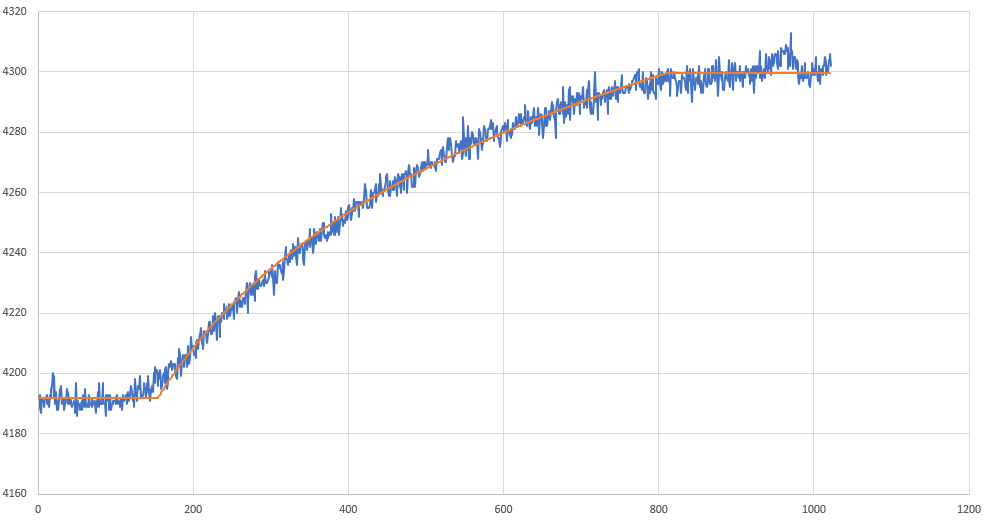
|
| Attachment 8: H102t870.png
|
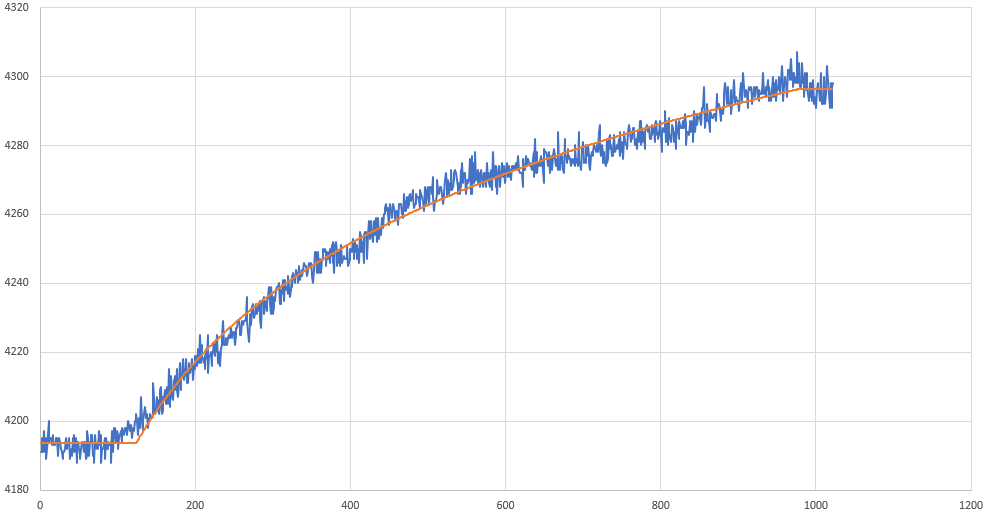
|
| Attachment 9: Comparison.png
|

|
| Attachment 10: R3pow_heat.png
|
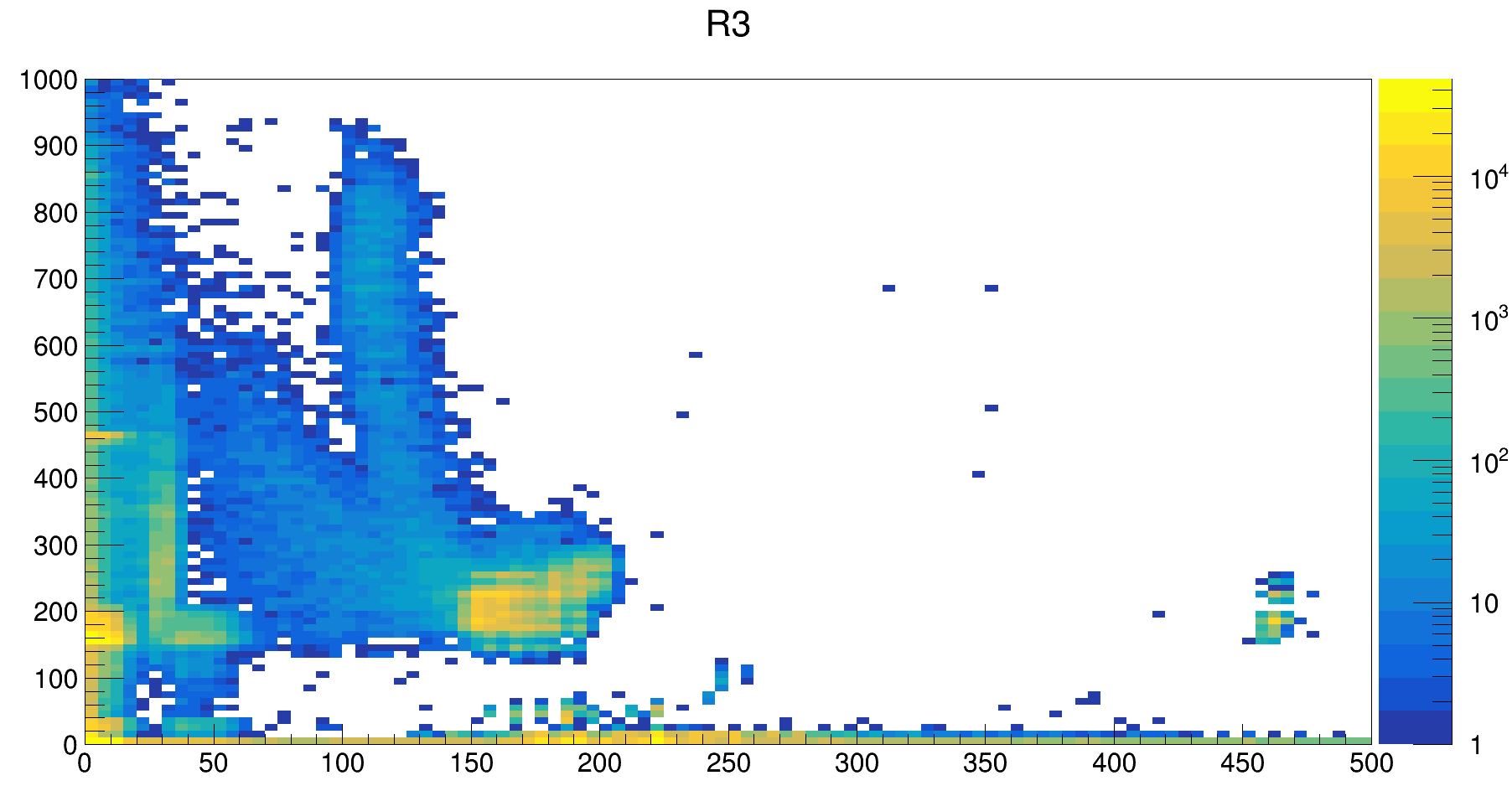
|
| Attachment 11: R3pow_t.png
|
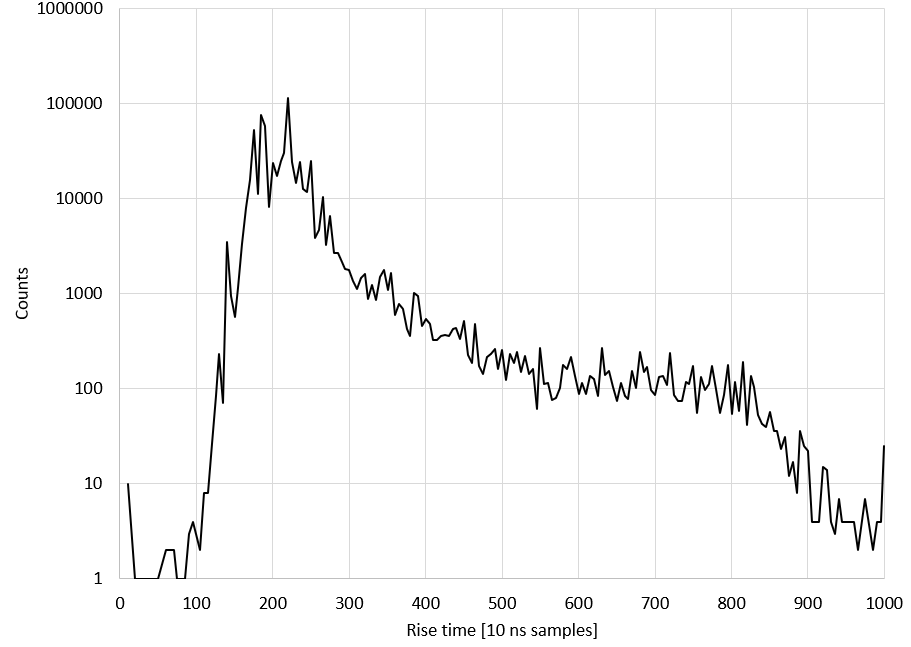
|
|
13
|
Tue Jun 1 14:59:06 2021 |
CB | 2021/R3_0 Analysis - 3 lines |
Fit: 3 lines
Free parameters: 2x boundary points between lines
Algorithm: Nelder-Mead, 10 iterations. (Centroid defined incorrectly from entire simplex instead of best two
vertices)
Attach 1 - height (difference between intercepts)
Attach 2 - rise times (x-diff between boundary points). Note peak at tr=100 is spurious.
Attach 3 - alpha signal. Fit from Excel Solver (GRG nonlinear)
Attach 4 - Signal incorrectly identified as H20 tr100 signal.
Fit displayed is correct, from Excel Solver (GRN nonlinear) tr seems 200 samples instead of 100 reported.
Attach 5 - Slow signal, poorly fitted by fitting functions
Attach 6 - Comparison between signals at H=110
Attach 7 - Heat map |
| Attachment 1: R3_H.png
|
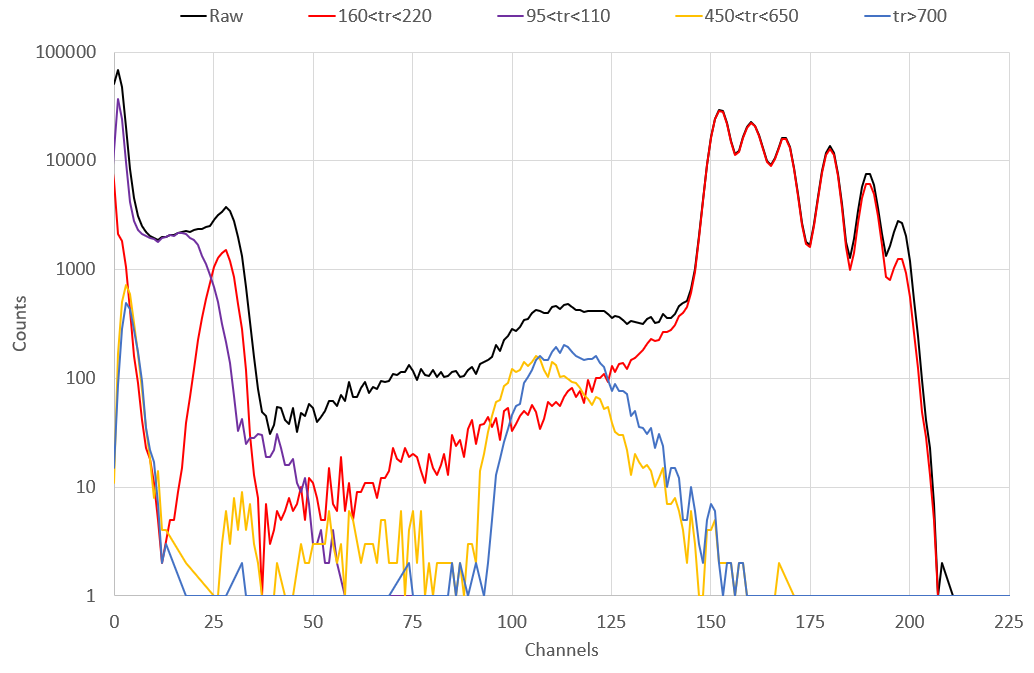
|
| Attachment 2: R3_t.png
|

|
| Attachment 3: Alpha.png
|
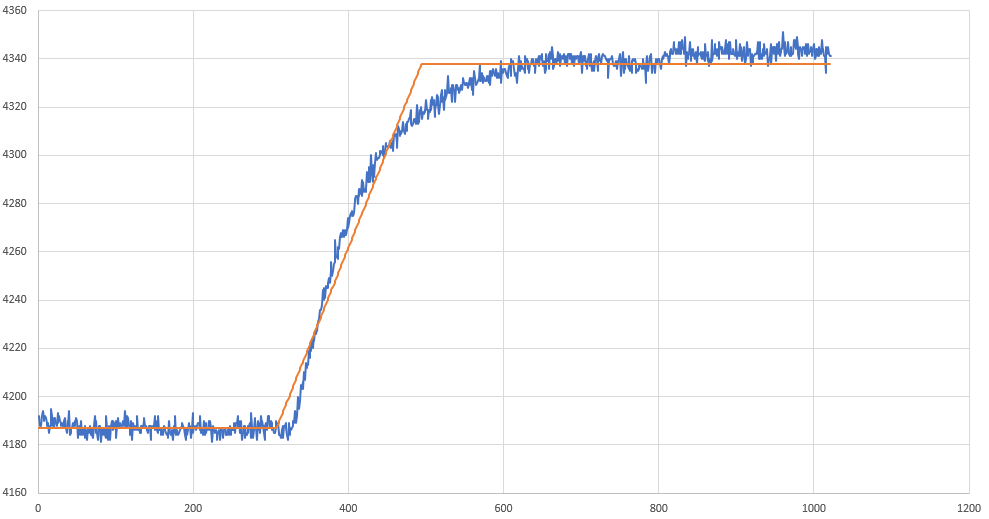
|
| Attachment 4: H20t100.png
|
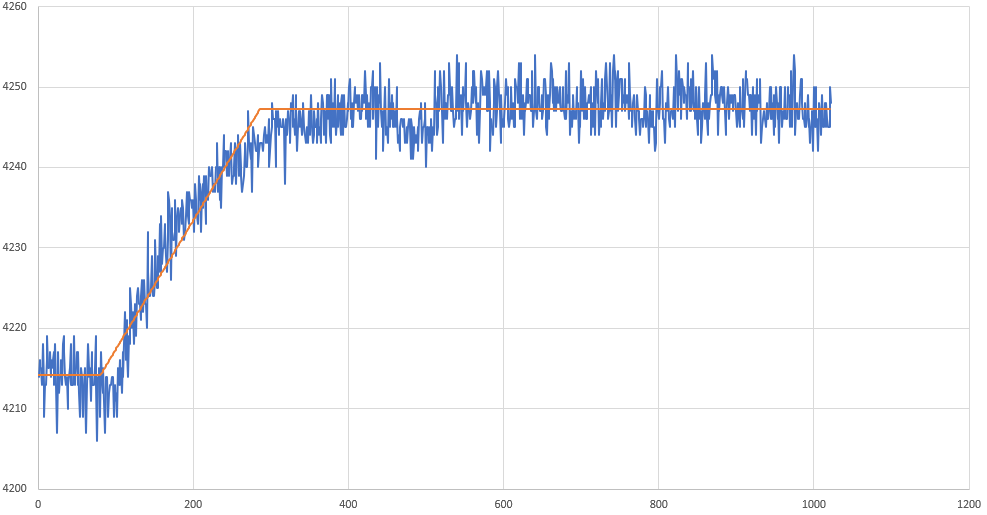
|
| Attachment 5: H110t730.png
|

|
| Attachment 6: Comparison.png
|

|
| Attachment 7: R3_0.png
|
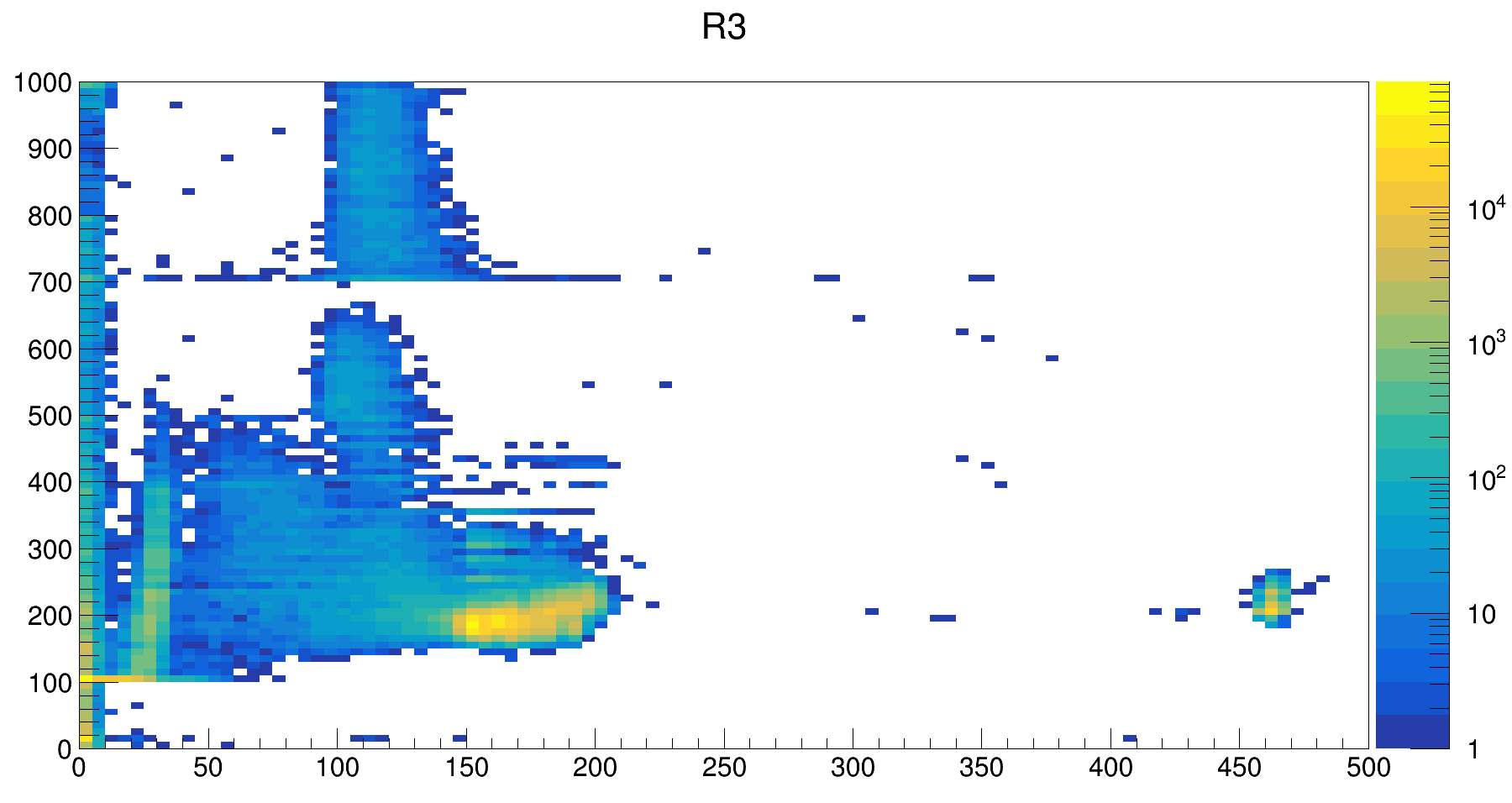
|
|
12
|
Sun May 23 14:02:58 2021 |
CB, PB, LdF | 2021 Runs - grade B MSL Si |
R1:
Same as previous configuration?
Negative signals.
No pulser
2048 window / 1000 pre-gate trigger
20 threshold / 44098 DC offset
3-alpha source
R2:
Detector rotated.
Negative signals
No pulser
2048 window / 1000 pre-gate trigger
20 threshold / 44098 DC offset
3-alpha source
R3:
Detector rotated back.
Positive signals.
2.5 Hz Pulser
1024 window / 700? pre-gate trigger
50 threshold / 48098 DC offset
3-alpha source
R4:
Detector as before
Positive signals.
2.5 Hz Pulser
512 window / 600 pre-gate trigger
50 threshold / 48098 DC offset
3-alpha source
R5:
Detector as before
Positive signals.
2.5 Hz Pulser
1024 window / 650 pre-gate trigger
50 threshold / 48098 DC offset
3-alpha source
R6:
As above. No alpha source.
Data acquisition stopped very early into the run. Lost contact with digitiser?
Upon re-establishing contact, signal digitisation looks extremely coarse in y.
Previously observed behaviour. Reasons unclear.
Calibrate ADC on V1730PSD panel seems to have fixed this.
However, baseline/offset/threshold clearly changed based on data rate and signal.
Lowered threshold.
R7:
Detector as before
Positive signals.
2.5 Hz Pulser
1024 window / 650 pre-gate trigger
40 threshold / 48098 DC offset
No source.
Data acquisition stopped very early into the run. Lost contact with digitiser again?
Did not reboot either PC or VME crate. Rebooted MIDAS only. Re-established contact. All looks good
R8:
As R7
Data acquisition stopped a few hours into the run. Same as before!
Did not reboot either PC or VME crate. Rebooted MIDAS only. Re-established contact. All looks good
R9:
As R7,R8
DAQ stopped again. Rebooted. OK. Issue needs to be understood.
R10
As above
DAQ did *not* crash!
R11
As above.
R12
As above, 208Bi source placed in chamber.
No obvious signal. Run stopped
R13
Pulser settings changed during optimisation.
Source location changed during optimisation.
---
Attempted to increase DC offset (->55098) and lower baseline (2400) to increase gain and make use of full
dynamic range.
Systems briefly triggers, contact with VME lost. Will need to reboot locally. |
|
11
|
Tue Feb 11 14:49:29 2020 |
CB, PB, IMK | 2020 runs |
Runs acquired in Jan-Feb 2020
Detector bias -50V
Bias applied to one strip only of B-grade silicon W1
Triple alpha source P9
500 samples pre-trigger
8096 total samples
- Internal triggering from CAEN v1730B digitiser
R1,2,3 - Cooknell preamps, positive waveforms
R4 - Skipped
R5,6 - RAL108 preamps, positive waveforms
- External trigger provided from Ortec TFA + CFD + Lecroy Level Adaptor
- 500 sample pre-trigger, but note trigger position in time now resents of dealay between signal and TFA+CFD trigger chain
R7,8 - RAL108 preamp, negative waveforms
- CFD threshold potentiometer cleaned. Threshold likely changed
- Reduced samples to 4096
R9 - RAL108 preamp, negative waveforms
- TFA failed & replaced. New gain settings Fine MAX (12.5x), Coarse 2x
- Samples stil at 4096
- Pre trigger window increased to 1000
R10 - RAL108 preamp, negative waveforms
R11 - RAL108 preamp, negative waveforms with Cs-137 gamma source
R12 - RAL108 preamp, negative waveforms at -25V bias
R13 - RAL108 preamp, negative waveforms at -75V bias
R14 - RAL108 preamp, negative waveforms with neutron source
R15 - RAL108 preamp, negative waveforms, background run |